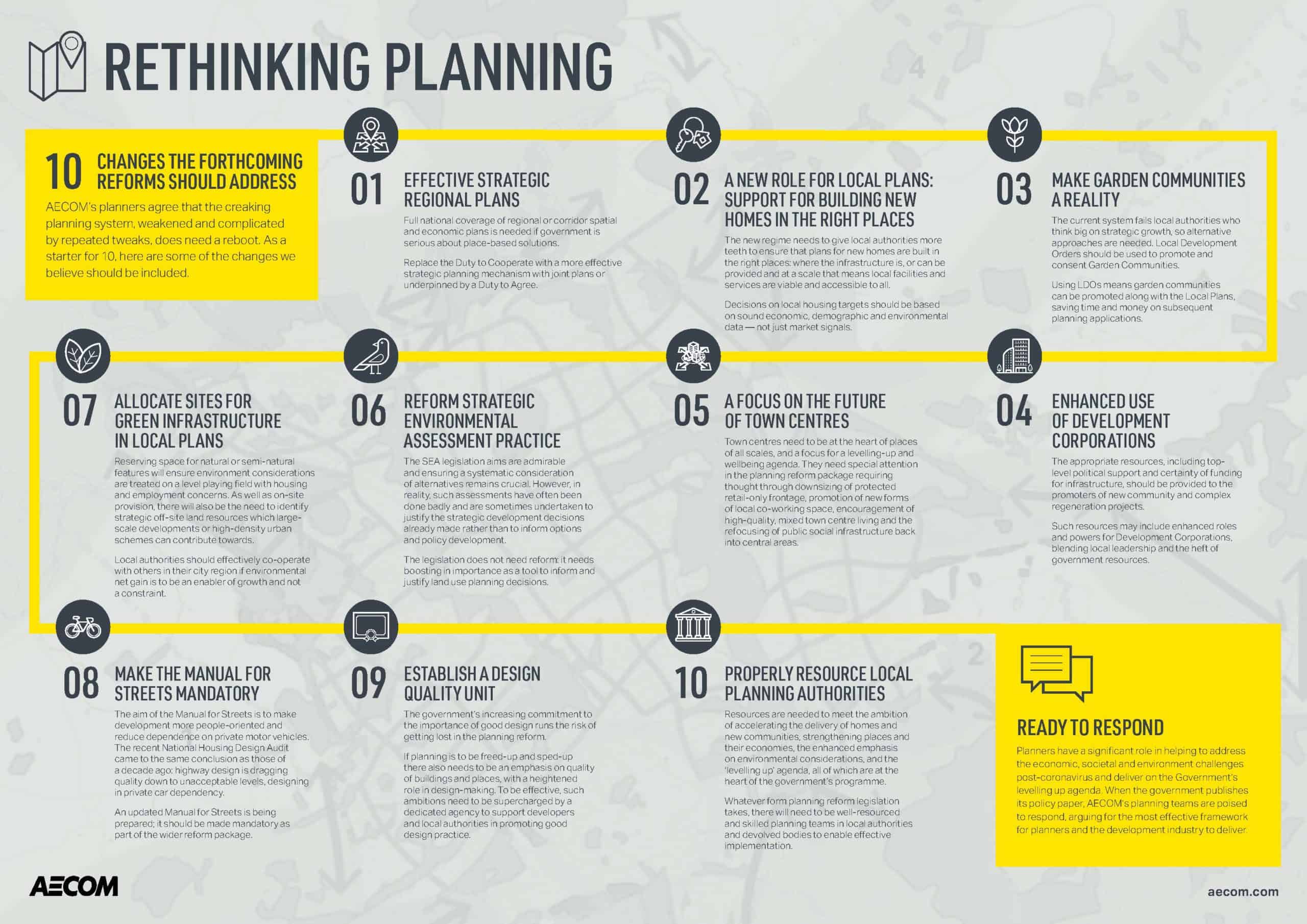The post Reimagining the travel experience through hotel design appeared first on Without Limits.
]]>
‘Revenge travel’ – the desire to travel more, further and for longer after being unable to during coronavirus – has continued into 2023, after starting in 2021. The phrase started as a tongue-in-cheek concept on social media, but such attitudes are being reflected in travel data.
Travel to the UK has almost recovered to pre-pandemic levels. Visit Britain’s latest inbound forecast for travel to the UK in 2023 is 37.5 million visits – 92 per cent of 2019’s visitor figures. Travellers are forecast to spend £30.9 billion in the UK this year, 90 per cent of the 2019 spend in real terms, after taking inflation into account. This means the hotels sector, which suffered greatly in the pandemic, is enjoying a return to normality.
However, what constitutes normal is changing. People may be travelling more and spending more on travel, many using money they saved up during the pandemic – but their expectations are now higher. Hotel guests crave experiences, not just a place to rest for the night. In another evolution, tourists and business travellers alike are more conscious than ever of their carbon footprint.
The relative weakness of the pound against the dollar has also led to a changing tourist demographic. There has been a rise in domestic tourism within the UK, and for international visitors, a perception that the UK offers good value for shopping and leisure compared to other international destinations.
What does the next generation of hotels look like?
New hotels distinguish themselves by delivering a unique, memorable, highly positive customer experience. The building fabric and design is crucial to providing this.
Developers want to create ‘destinations’ – places where people want to be, see, and experience, even if they are not staying in a room there. These experiential aspects of a new hotel could centre around a rooftop bar, a ground level coworking space, or an art gallery, a music venue or a florist attached to the hotel lobby. The goal is to make hotel a place to meet and gather, not just to sleep.
Hotel design and visuals should be anticipated to be photographed and shared on social media, particularly among younger customers. YouGov reports four in 10 (39 per cent) under-25s now use social media platforms as their primary source of information when making travel bookings. Original artwork, unusual building features and high levels of biophilia are all ways to add appeal to Gen Z.
In contrast to the trend for providing a wide range of amenities, some hotels have scaled back on amenities and focus instead on providing low-cost, compact rooms designed for short stays. The growth of serviced apartments and aparthotels has also challenged preconceptions and expectations of what a good hotel experience should look and feel like.

Food and beverage (F&B) provision
Room occupancy forms the bedrock of a hotel’s profitability, but a successful food and beverage provision is now also important. As retail spaces reduce, hospitality is stepping further into F&B space. Socialising trends are evolving too, with food and restaurants now being a huge reason to meet and to travel.
When planning F&B and amenities, the local area should be thoroughly investigated. There is a nascent trend for new hotel developments to form agreements and partnerships with large local entertainment providers, such as stadiums. The post-pandemic return of big-ticket sports and music events with thousands of attendees has led to demand for nearby hotels to meet the spikes in accommodation and F&B needs of local major venues.
Health and wellness
Wellness is a buzzword. The Global Wellness Institute reports ‘wellness tourism’ is set to grow more than any other wellness sector, increasing by 20.9 per cent by 2025. In the hotel sector, this is reflected in increased demand for amenities such as yoga studios and access to wellness experts, classes, workshops and health retreats.
For hotel guests, the pandemic means there is a desire for antimicrobial finishes and passive measures to reduce the amount of physical contact users have with the building. This includes the introduction of kick plates to remove need to open doors using hands/door handles, and a focus on automatic sensor lights for rooms and toilets.
For hotel employees, everything at the outset should be designed to enable quick room turnarounds. Not only does this reduce cleaning times, but it can also improve the next guest’s experience, as the hotel is thus able to offer an earlier check-in.
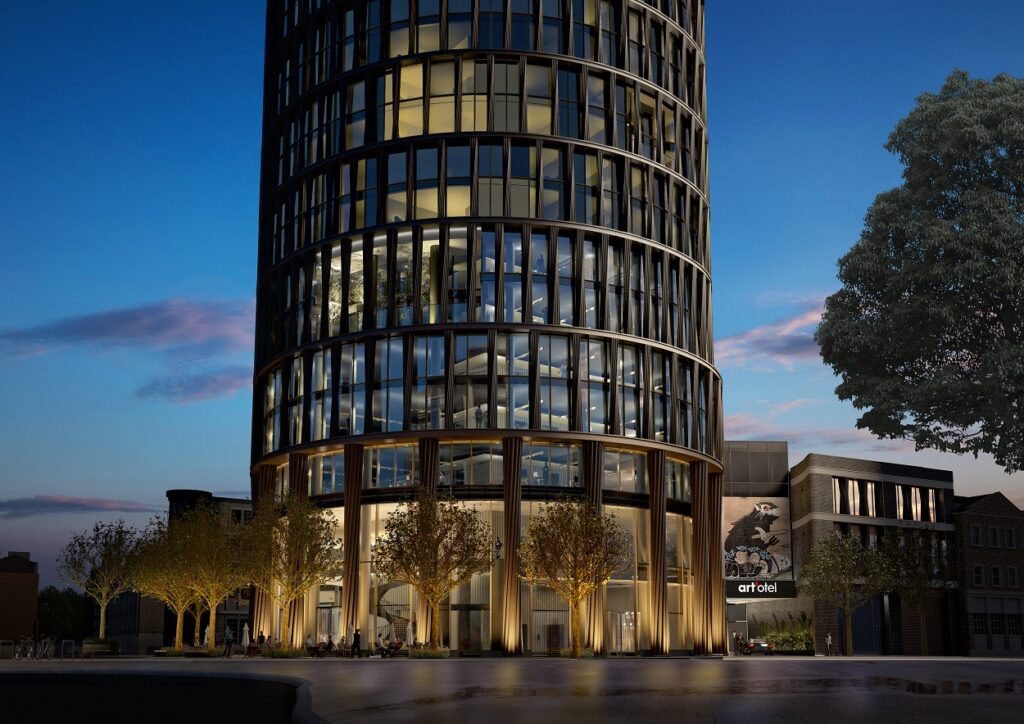
Fire safety
Branded residences within hotels or aparthotels are making designing for fire safety complex. Branded residences are classed as residential spaces, and thus must comply with the Building Safety Act. The full ramifications of the new 2023 regulations may take some time to unfold, but it is likely to have a significant impact on project costs. The rollout of the new regulations is being monitored closely by industry.
Sustainability
Green travel is a booming sub-sector within travel, and customers increasingly want to stay in and associate themselves with hotel destinations that align with their values and green aspirations.
As a result, there is a strong shift towards new hotel developments achieving excellent or outstanding BREEAM (Building Research Establishment Environmental Assessment Method) ratings and showcasing sustainable developments to guests.
In a key shift since 2020, developers are now concerned with how to provide electric vehicle (EV) car charging infrastructure for their guests. There is a strong mechanical, electrical and plumbing (MEP) element to car charging provision, as it demands a high electrical load. The addition of EV charging also necessitates additional fire protection measures, further increasing overall costs to developers.
Redefining the future of hotel design
In a challenging macroeconomic environment, smart, efficient, flexible design will be critical to hotel profitability and success. Meeting stringent, data-backed sustainability and net-zero standards is also key to future-proofing buildings and attracting loyal customers who are proud to be associated with the hotel. In a world dominated by social media, providing great photo opportunities for guests and creating memorable moments and experiences is also key.
We are working at a time where the definition of luxury, high quality, business, and budget hotels is being redefined. We are redrawing the lines around what a hotel should look like, feel like and provide to users, with technology, economic and health considerations deeply influencing this. For industry, the challenge is being aware of — and responsive — to these rapidly changing norms.
Cost model: Mid-range, four-star new-build hotel
We have built a cost model that considers the design and cost associated with a mid-range four‑star new-build hotel of 12,000m2 GIA and 200 keys in central London. The cost range for a new hotel of this nature is wide and could vary from £4,000/m2 to £8,500/m2 depending on project specifics such as size, stature, site specifics, location, design and specification, area efficiencies and the extent of guest room or front-of-house offering.
Click here to download the cost model.
This is an abridged version of an article that was first published in Building magazine. You can read the full article by clicking here.
The post Reimagining the travel experience through hotel design appeared first on Without Limits.
]]>The post Building low-carbon commercial offices appeared first on Without Limits.
]]>
Rising public knowledge and concern surrounding the climate crisis are placing pressure on developers to deliver decarbonised buildings. People are increasingly demanding that their workspaces align with their values: research this year by KPMG found that 20 per cent of UK office workers would turn down a job if a company’s environmental, social and governance (ESG) factors were deemed lacking. Almost half of workers want their employers to demonstrate climate and social commitments.
Progress is undoubtedly being made in commercial office space decarbonisation. However, a by-product of the numerous guidelines, targets, and standards created to help us reach net zero means that there is not one single accepted definition of what a net zero building is. There are varying, and at times conflicting, rules for the industry to adhere to.
Complicating matters further, these metrics and guidelines are constantly developing and being refined. It is therefore important to set clear objectives of what we are looking to achieve. One useful – and ambitious – metric is LETI’s upfront embodied carbon emission targets. These apply for building elements at the product sourcing and construction stage, excluding sequestration. This targets 350kg CO2/m2 by 2030, with 50 per cent of building materials from re-used sources and 80 per cent of materials used to be able to be re-used at the end of the building’s life.
As of 2023, this target is not being reached – 500kg CO2/m2 is considered best in class. We use the 500kg CO2/m2 metric as our benchmark for a low carbon building targeting net zero in this cost model.
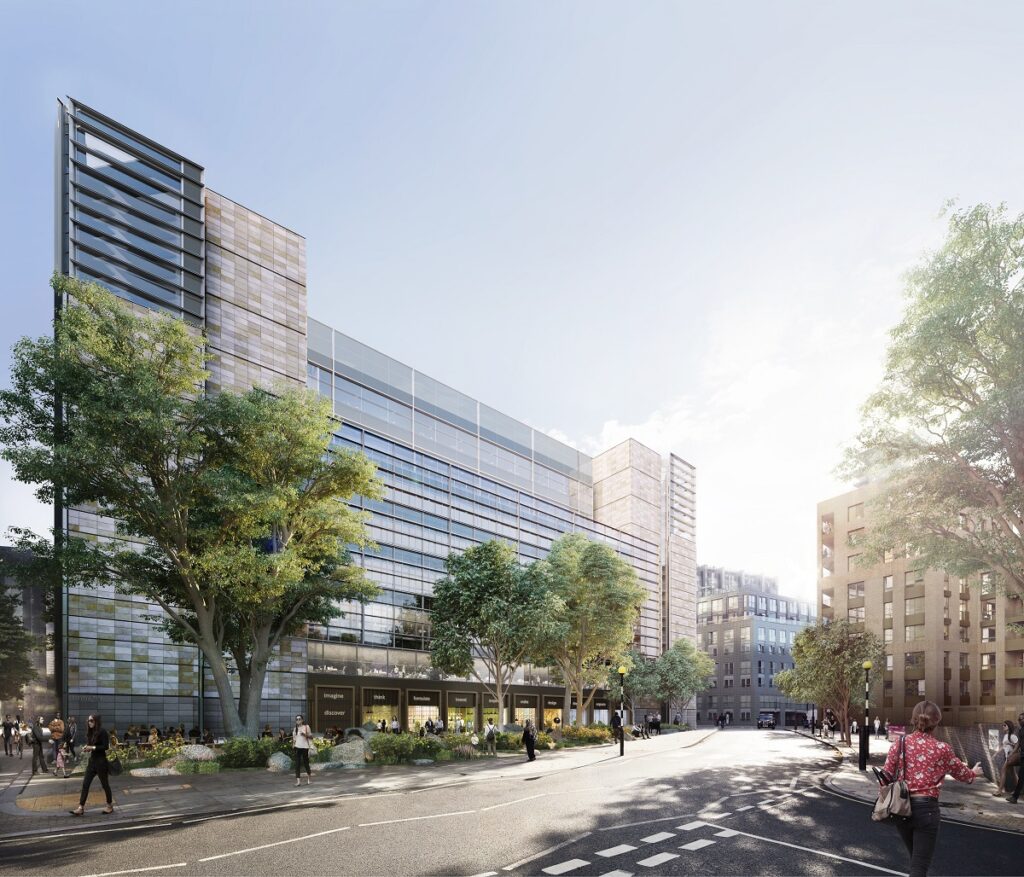
New build versus refurb
Embodied carbon is the most important and carbon-intensive factor to consider when designing for net zero. As the embodied carbon profile of a refurbishment project can be lower than a new build development, we are witnessing a shift towards a refurb-first approach to delivering projects across the UK. This is part of a general drive towards making the use of new materials in buildings a last resort, rather than first choice.
Yet choosing a refurbishment over a new build does not guarantee the lowest-carbon result. When measuring a project’s carbon profile, choosing between whole life versus upfront carbon measurements is a key factor to consider when trying to deliver the lowest carbon project possible. Typically, a refurbishment option will have a lower upfront carbon footprint. However, when assessing the whole life carbon of the building, the efficiencies associated with a new build scheme could close the gap.
Solid, accurate modelling and data are required to make sure the right assessments and choices are made as to whether to pursue a new build or refurb development.
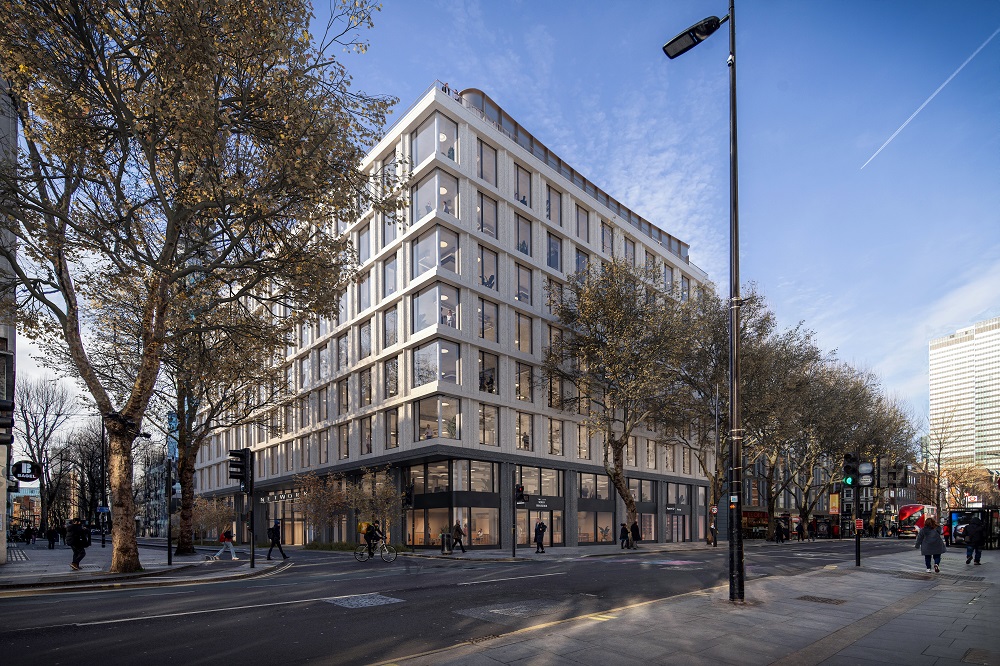
Design considerations
The market (developers, tenants, agents) perceptions of what makes a Grade A office space need to include sustainability credentials, but this may conflict with other aspirations, such as the desire for large, open plan spaces. To meet these sometimes competing demands, traditional specifications should be challenged.
If retaining existing buildings, reviews of the product and the specification level required – or that tenants are prepared to accept – are essential for a clear design solution to be achieved. Lateral thinking is important. For example, some schemes are now prepared to embrace smaller column grids and less stringent environmental conditions.
When deciding what to re-use, and what to build or procure as new, the following design factors should be considered:
Sub-structure
- Basements. Our preliminary research suggests a basement could emit the equivalent of between two and three storeys of superstructure frame based on a typical single-storey basement of a mid-rise residential building. The industry is increasingly looking at how the basements inherited on schemes can be incorporated and re-used.
- Re-use of existing foundations/pile. The cost and viability of re-using and strengthening existing foundations should be the first potential solution to investigate, as it reduces the need to build new. With new sub-structures, the use of hollow piles, which reduce carbon by cutting material volume, can be considered. Precast, reusable, UK-sourced commercial hollow pile products are growing in use and availability.
Structure/Frame
- Concrete. Reducing concrete through design measures is the most effective way to cut the carbon impact of a project. Where concrete cannot be re-used or, in a new build, reduced through design, products are emerging to attempt to reduce its carbon intensity.
- Steelwork. The carbon intensity is influenced by the amount of steel specified for a frame, so the design should aim to minimise the amount of steel used. Reused steel can have a carbon intensity as low as 50kgCO2e/t, compared with a sector average of 1740kgCO2e/t for new steelwork.
- Structural grids and depths. A key driver for inefficient structural frame design is the current aesthetic preference for open spaces and concealed structures. By reducing grids, up to a point, significant efficiencies in the structure will be found in both the superstructure and substructure.
- Cross-Laminated Timber (CLT). CLT is a glued product, which can make it hard to break down, re-use or re-purpose. This may act at odds with circular economy principles and the sequestration benefits may be lost depending on the building’s end-of-life scenario.
MEP
- Recent calculations by the GLA suggest that services contribute 21 per cent to the whole life carbon output of a building. MEP decarbonisation is achieved by challenging norms; and optimising the efficiency of kit and its usage and control.
Finishes
- Developers are examining how they can dematerialise projects, cores, landlord and common areas that have the basic structure as the finish, sometimes with an enhanced finish from the original basic structure, without having to add further applied finishes to structure, which adds carbon.
Making net zero offices commercially viable
Net zero office buildings must evolve from being theoretical, to fully realised. For industry, the challenge is balancing cost versus decarbonisation. The overarching question is, how can we achieve lower carbon buildings in a financially viable way?
Right now there are more questions than answers. Existing norms must constantly be questioned if effective, consistent progress towards net zero is to be made. By making the most of disruptive technologies; choosing the most relevant, adaptable, low-carbon materials and processes; and by committing to industry-wide collaboration, we can answer these questions.
Cost model: Net zero offices
We have built a cost model calculating the cost and carbon of a new-build ground plus eight-storey commercial office building in a central London location. The report also includes a table which summarises the cost and carbon for two options to deliver the same overall size office building: the first is a complete redevelopment demolishing the existing structure and building new, and the second is a comprehensive refurbishment where the existing structure is retained and extended to achieve the same overall GIFA of 232,000 square feet.
Click here to download the cost model.
This is an abridged version of an article that was first published in Building magazine. You can read the full article by clicking here.
The post Building low-carbon commercial offices appeared first on Without Limits.
]]>The post How can urban planners influence the 15-minute city narrative? appeared first on Without Limits.
]]>The concept of 15-minute city has gripped public and political debate with opinions ranging from the simple and compelling views that locating most essential services and amenities within walking or cycling distance from our homes supports the shaping of sustainable communities, to the more extreme view that the concept infringes personal liberty.
Despite the strength of the concept, there isn’t yet a real-life example of a 15-minute city that has been built. Instead, the concept’s application in recent years has been mainly associated with the construction of cycling lanes, the planning longer-term low-traffic arrangements or sometimes with adding a bit more amenity in local neighbourhoods. So, with few meaningful reference points, the concept is highly malleable by media. If it is to be supported, it matters that the concept is used appropriately, maximising its full potential and not just focus on singular, mostly traffic-related applications.
As planners, to keep support for the concept, we need to ensure that our profession is aligned on the wider benefits of a 15-minute city and what it might look like, so that we can help reframe the narrative.
It’s about balancing the mobility network, not a battle against the car
Cities have an obligation to reduce transport emissions. It’s a complex task and reducing car use can only be achieved meaningfully when other low carbon, and as attractive, means of transport are provided.
People have the right to use a car, particularly in places where there are no relevant alternatives. The main question is when do we use the car, and what for? Better planning of local neighbourhoods will create choice, with more attractive, healthier, and safer options to move around. The car (hopefully a zero emission one, or a shared one) can then be used when needed but not as first choice.
The challenge is transition, as people are asked to change their behaviours and adapt to a new normal which impacts their daily routines. Whilst new developments such as King’s Cross, for example, prioritise walking and embed low traffic principles very successfully, residents and businesses that choose to locate there mostly buy into this from day one.
So, what can we learn from great places like King’s Cross? I believe its success is not just because of how well it has been planned but also because of the quality of place delivered (as well as how it is maintained and ran). Quality delivery is key to stimulating behavioural change.
Create and communicate the ripple effects of infrastructure
Cities must ensure that they can maximise the value of the investment in infrastructure, to create truly sustainable places. The 15-minute city concept can bring more benefits to local communities from infrastructure development, for example using the investment to spur regeneration around stations. Designing and delivering integrated developments around transport nodes helps maximise the value of the investment in infrastructure, delivering wider services than transport, such as housing and other mix of uses, within walking distance of the station – there are some great examples of this, particularly across Asia, such as West Kowloon Station in Hong Kong.
Looking beyond transport, larger developments present opportunities to rethink green and blue infrastructure including better and greener streets, a more attractive network of public open spaces and parks including spaces in buildings such as sky gardens and green facades, delivering comfort, microclimate protection, biodiversity, and other sustainability and place making benefits.
Stratford and the Queen Elizabeth Olympic Park in London is a great example where planners leveraged the value of the park and concentrating high-density development around transport nodes, shaped a range of places that are highly walkable, vibrant and safe for local communities, workers and visitors.
If embraced by local communities and when making economic sense, integrated sustainable infrastructure can become one of the most positive catalysts for shaping the future of our cities.
Settling the challenge of business district vs suburb
One of the challenges about the 15-minute city concept is the negative impact its local focus – and supporting more working from home – might have on central business districts (CBD) which thrive on an ecosystem of people coming in to work by public transport, going out for lunch, and socialising in the evening.
However, this isn’t the case of one against the other. Good cities are planned as a holistic network, where central urban areas and suburban neighbourhoods complement each other.
In Sydney, Australia, there is now a strong push to make the CBD relevant again, not by attracting 9-5 workers back, but by diversifying the offer as a mixed-use piece of city, attracting a much wider range of businesses as well as residents, around a 24/7 environment.
In Melbourne, the city’s largest infrastructure project in decades – the Suburban Rail Loop (SRL) – presents a once-in-a-generation opportunity to revive suburban environments by making new stations focal points for new ‘centres’. This supports the city’s long-term plan which promotes ‘living locally’, providing people more services and opportunities closer to home.
Delivering much needed change to the city’s building stock
With most of the decarbonisation efforts now focused on retrofitting existing stock, the 15-minute city offers an opportunity to do a ‘deep dive’ into local areas.
Following the coronavirus pandemic, many employees have seen their offices getting a much-needed facelift with more collaboration space and a friendlier, more relaxed environment – attracting workers to come back to the office, for at least part of the week. Local high streets and town centres, which have struggled to adapt to the change in the retail landscape following the rise in online shopping, have seen new uses like wellness, shared workplaces, galleries and local artisans take up vacant retail units.
These new uses encompassing retrofits are a fantastic opportunity for cities, enabling significant gains from a carbon perspective but also enhancing place quality and experience. For urban environments, which usually take years to adapt and evolve, there are opportunities to increase the pace of change.
Conclusion
The 15-minute city concept isn’t a ‘one size fits all’ plan. It is not meant to be a perfect model for new city living, simply because there isn’t one. It is there to present and guide to a different future – shaping more liveable places, healthier and more sustainable communities.
There is much more to the 15-minute city than how we move around. If considered holistically, it gives us useful tools to balance global challenges of climate change, economic instability or health and to balance those with the needs and aspirations of local communities. As urban planners, we should align behind these wider benefits so that the narrative moves on from the concept simply being about car use or working from home.
This article was originally published in The Planner.
The post How can urban planners influence the 15-minute city narrative? appeared first on Without Limits.
]]>The post Decarbonising real estate starts with intelligent planning and design appeared first on Without Limits.
]]>Reducing the carbon impact of existing building stock is a time-critical task for the industry, as the consequences of human-induced climate change are now tangible. In 2022 alone, the UK experienced its warmest year on record, according to Met Office data. The past year has also seen heavy rainfall, flooding, urban wildfires, and other extreme weather conditions in the UK and on a global scale – all of which are being experienced with increasing frequency.
The scale of the decarbonisation challenge cannot be underestimated. Existing building stock accounts for approximately 23% of UK carbon emissions, according to a 2019 Royal Institution of Chartered Surveyors report. In the housing sector alone, the UK Green Building Council estimates that the UK’s 29 million homes must be retrofitted at a rate of 1.8 every minute to achieve net zero by 2050.
The public sector
Despite immense funding pressure, the UK public sector has in many cases led the way in estate decarbonisation investment. Initiatives such as the Public Sector Decarbonisation Scheme (PSDS), launched by the Department for Business, Energy and Industrial Strategy, are injecting cash into improving public buildings by stripping out carbon and energy inefficiencies.
The PSDS has to date provided around £1.6 billion in grant funding to help public sector organisations improve the energy use of existing buildings, and to reduce their reliance on fossil fuels. Additionally, the Public Sector Low Carbon Skills Fund provides grants for public sector bodies to engage specialist advice to develop decarbonisation plans for their estate.
The private sector
For private estate owners, the investment case for decarbonising their buildings centres around both highlighting their ESG credentials and preventing assets from becoming stranded. Assets become stranded when their value is vulnerable to external factors such as changing regulation, technological innovation or evolving social norms.
In real estate, legislation preventing assets with poor energy efficiency from being occupied is a growing risk. There is also rising pressure from fellow asset owners: initiatives such as the Net-Zero Asset Owner Alliance requires members to reduce emissions across global property portfolios.
To mitigate this risk, tools are emerging to help estate owners assess the likelihood of their assets becoming stranded. The European Union (EU)-funded Carbon Risk Real Estate Monitor (CRREM) is a tool that allows investors and property owners to assess the exposure of their assets to stranding risks based on energy and emission data and the analysis of regulatory requirements.

Factoring energy efficiency into design
Cutting carbon by increasing energy efficiency typically involves improving the thermal efficiency and air tightness of the building fabric, along with the installation of energy-efficient plant and smart building control technology. Energy assessments will provide guidance on what is possible at each site.
A fabric-first approach is important. Improving mechanical, electrical and plumbing engineering (MEP) systems in a building with a poorly performing external envelope has limited value. In contrast, upgrading facades, adding insulation, and increasing air tightness are all effective interventions and are often the first point of focus when taking on a retrofit challenge.
That said, improving the heat efficiency of the building fabric can often create an increase in whole-life carbon. Given their carbon intensity, is only advisable to undertake full cladding replacement if the existing system is damaged, performing poorly or nearing the end of its useful life. A holistic approach should be taken to considering the impact of building fabric changes – overheating and condensation, for example, can be consequences of failing to consider how a replacement building fabric will interact with existing building components.
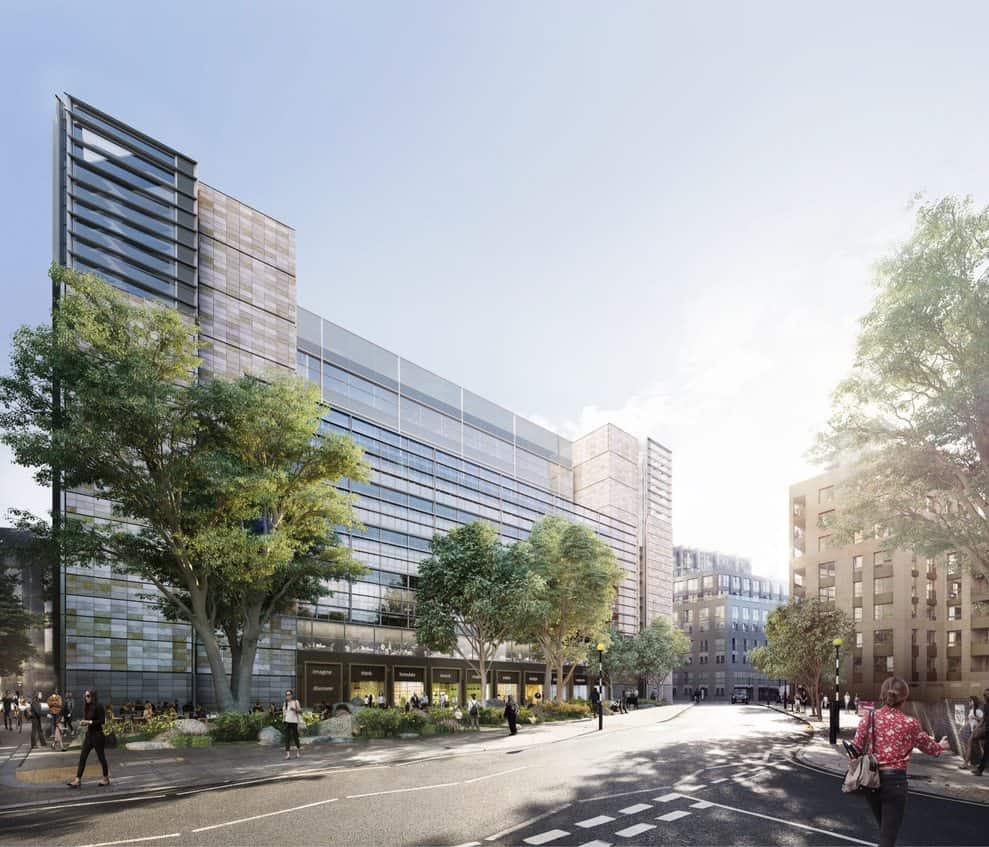
Once decisions about the external fabric and structure have been made, it is important to understand how a building is used. Heating, cooling and lighting unoccupied space is costly in both monetary and carbon terms, yet if building occupier patterns are fully understood, this is a relatively easy way to quickly cut carbon output and energy costs.
This can be done through installing building-level controls to enable efficient building management. Controls are key to ensuring energy use is minimised and the benefits of natural ventilation are explored and incorporated where feasible. Incentivising efficient occupier behaviour is another important way to reduce energy demand.
Introducing onsite renewable energy generation capability is something developers are often keen to explore, as it is typically a highly visible example of a building’s efforts to be more sustainable and can help achieve higher EPC ratings. However, it should be noted that as electricity sourced from the national grid decarbonises, the operational carbon benefit of onsite production lessens.
Full grid decarbonisation is still decades away, but we are swiftly moving towards renewables becoming the dominant source of on-grid power. Onsite generation has other valuable benefits, such as energy security and the potential to sell energy to the grid, but electrification of existing plant has the biggest impact on carbon reduction.
Creating holistic decarbonisation plans
For real estate owners that are yet to consider these issues, thinking ahead of time and having a plan in place for estate decarbonisation will enable them to be nimble and take full advantage when new funding streams or supportive initiatives are announced. Tax policy is one area in clear need of greater government support. That UK policy currently favours new build developments over refurbishment is bewildering in the face of our climate goals, and needs to change.
Public sector support – directly through grant funding, targeted initiatives, and regulatory change – is key, but is only one part of the solution. Private sector action on estate decarbonisation is crucial and is an important part of the jigsaw which cannot be ignored. More instruments are needed to accelerate this market, whether in the form of a carbon tax, or a shift in the relative prices of gas and electricity or other solutions.
The construction industry, the financial community, and asset owners must all pick up the pace on estate decarbonisation if both the UK’s and other international carbon targets are to be achieved. In the face of soaring inflation, a recession, labour and materials shortages and a lack of knowledge in the sector on the topic, it is an indisputably difficult task. Success in these conditions may be about trade-offs and compromises – and collectively creating holistic decarbonisation plans to break the decarbonisation challenge down into achievable steps, one project or estate at a time.
Cost model: Estate decarbonisation
We have built a cost model for the core baseline costs for different interventions that should be taken into account before building a more detailed, and informed, view of project-specific costs. Indicative cost ranges provided in this cost summary are in Q4 2022 prices and rates reflect the national average.
You can download the cost model here.
This is an abridged version of an article that was first published in Building magazine. You can read the full article by clicking here.
The post Decarbonising real estate starts with intelligent planning and design appeared first on Without Limits.
]]>The post Designing logistics centres that can keep pace with demand appeared first on Without Limits.
]]>After a turbulent period which started with Brexit and was sustained by coronavirus, materials, labour and supply chain issues have now been ramped up by the conflict in Ukraine. Wider economic inflation, in turn, is driving costs to all-time highs.
Yet the most surprising thing about the logistics market at present is that it is buoyant in the face of these staggering materials price hikes. The industrial market has experienced double-digit increases on build cost over the past eighteen months – leading to an incredibly challenging time for market participants, where demand is high, but supply of key elements is low.
Logistics buildings typically have a very simple design, comprising an envelope of structural steel, a concrete slab, and then cladding on the walls and roof. However, with steel and concrete now in high demand and low supply, logistics centres’ need for large amounts of steel means costs and delays have become particularly pronounced. Steel and concrete are also energy intensive products to produce. As energy pieces rise, production costs have also soared.
How inflation impacts procurement
The typical procurement route for this building type is changing. A previous preference for single-stage tendering is now changing in favour of two-stage tendering, and to a more partner-based approach. Many of the bigger developers are even bypassing two-stage tendering – instead, going straight to a partnership with a contractor at an early stage, in order to try and lock in prices and contractor availability.
January 2022 saw some of the sharpest materials price increases on record. To offset building costs, rental prices are rising on units. This shift in yield has helped upcoming and in-development projects to continue to be financially viable. The problem developers face doing deals going forwards is how to predict build cost, and whether deals can be achieved on a fixed-price basis.
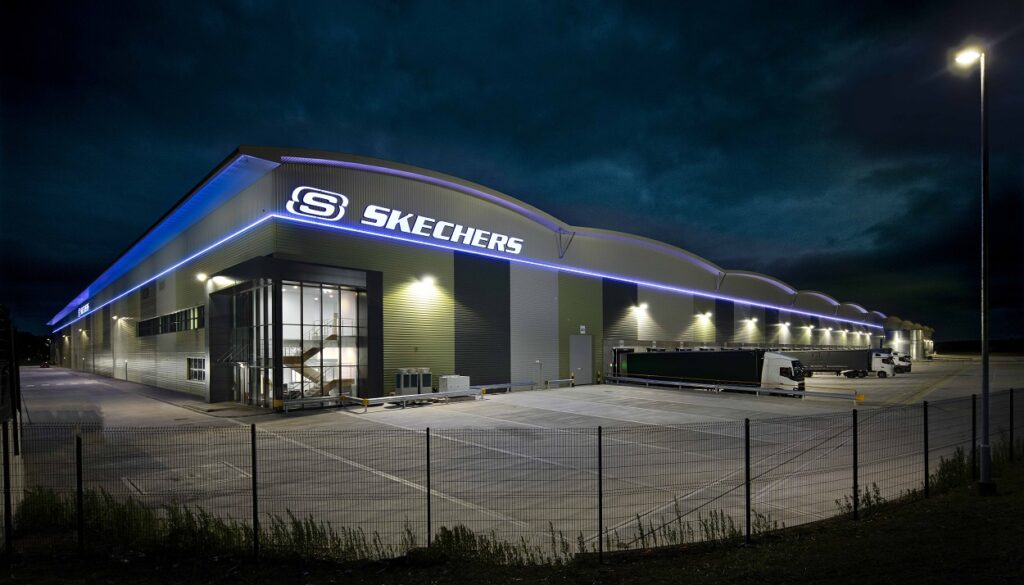
Design with end use in mind
The biggest change with this building type over the past decade has been the shift to ecommerce, which now dominates demand. All retailers are assessing their ‘dark lstores’ and last-mile facilities and want to use them to help gain a competitive advantage over rivals – by ensuring their logistics centres enable the fastest and smoothest order fulfilment.
While logistics centres are relatively simple in design, there are differences in facility layouts and heights based on what stage and type of fulfilment they are catering to. Last-mile logistics centres typically have a ground-based operation inside the building. They do not require high racking and are often laid out like a supermarket, with staff doing the picking rather than shoppers. In contrast, larger distribution centres, perhaps leased or owned by major international online retailers, feature high bay racking, and often deploy greater levels of technology and robotics for picking products.
Therefore when developing a shell, it is important to consider the expected end use. For example, a fulfilment centre which has heavy amounts of robotics may need to reconsider the use of roof lights, windows, and sources of natural light, which can confuse robot tracking and motion sensors.
Amenities for the people who working in logistics centres are improving, as labour shortages make it more important to attract and retain workers. Some core features are found in almost every project – such as a canteen, showers, changing and toilet facilities, and a large car park. However, gyms, sports fields, trim trails and additional EV charging points for staff cars and grassy outdoor meeting or relaxation areas have all been included in recent projects, to attract tenants and retain labour.
To maximise value, some tenants are opting to make their distribution centres also their HQ or primary office location. This may also drive-up demand for enhanced staff amenities and increased office design. Offices are typically fitted out to Cat A.
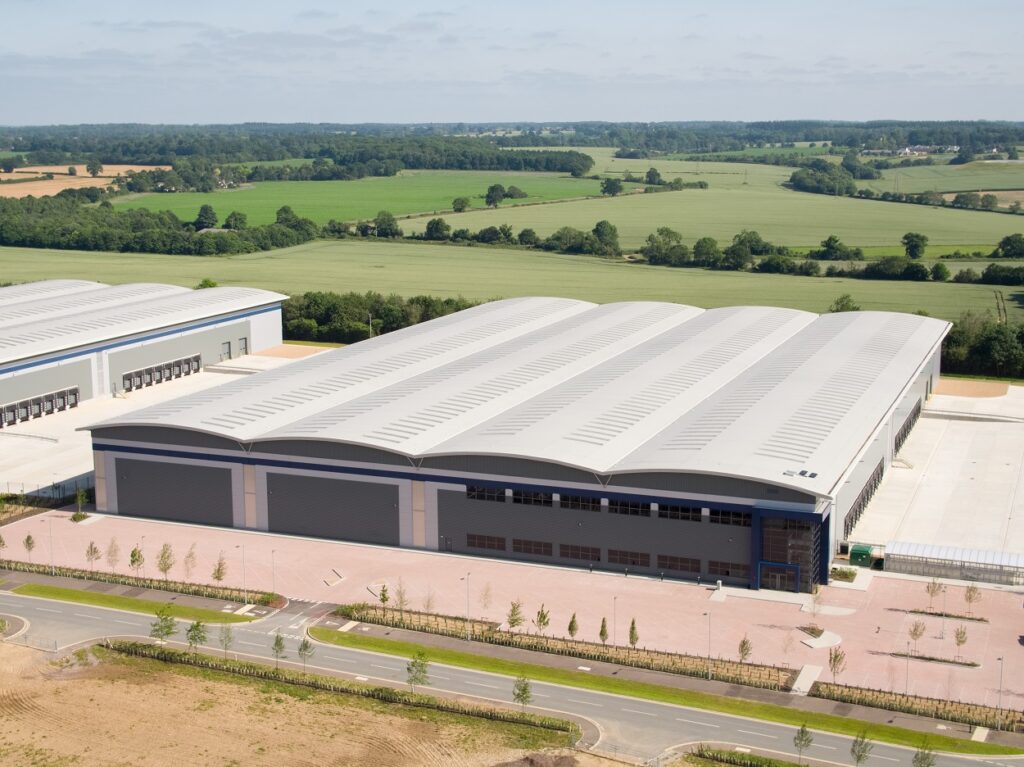
Making logistics centres sustainable
Because logistics centres are such large, open spaces, the cost impact to improving sustainability is relatively small compared to the cost of the building itself. BREEAM Very Good is easily achievable with speculative logistics developments, and is now a baseline; BREEAM Excellent status is also being reached on some projects where tenants have demanded it.
Logistics centres, with their large flat roofs, are obvious choices for solar PV installation and this is now commonplace. Some developers are selling the electricity generated from their rooftops to tenants. Making logistics centres self-sufficient from an energy perspective will likely become a strong selling point soon.
Location also informs what sustainability measures can be included. Rainwater harvesting, on-site wind turbines, EV charging points at every delivery van space and water attenuation are all being deployed on projects.
A smarter and more efficient future
Rather than a case of ‘survival of the fittest’, where only the largest contractors or tenants can take on and manage the risk associated with the inflation happening on these projects, it may turn out to be survival of the smartest – those industry players who can collaborate with the right partners; secure prices, labour and materials as efficiently as possible; and keep watch and respond to the retail trends which are influencing demand for these buildings.
Cost model: Distribution warehouses
We have built a cost model for a shell logistics building in a central UK location. The parameters are set around a gross internal area (GIA) of 159,900ft² (14,855m²), including a 475m² office fitted out to category A, powered by a pure electric system. Unit rates are derived from competitive design and build tenders and current at 3Q 2022.
You can download the cost model here.
This is an abridged version of an article that was first published in Building magazine. You can read the full article by clicking here.
The post Designing logistics centres that can keep pace with demand appeared first on Without Limits.
]]>The post How carbon and wellness principles are driving office design appeared first on Without Limits.
]]>Coronavirus is not fundamentally changing office design. Home working, hybrid models, hub-and-spoke offices, ‘resimercial’ design – all of these concepts were in existence long before early 2020. The pandemic has merely acted as a catalyst for their growth, propelling them from trends to established norms.
What has changed is employee expectations of what constitutes a ‘good’, healthy, productive workplace. The balance of power has shifted towards the employee, and their needs are now influencing office design just as much, if not more, than their employers. Working three days at home and two days in the office is no longer a benefit that must be ‘earnt’ or negotiated. Instead, it’s an expectation.
After two years spent working largely from home, employees are now more educated and engaged in hybrid alternatives to the fixed-desk office than ever before – and are willing to leave or join companies if they cannot offer working patterns and office spaces that fit their lifestyles, as seen in the ongoing ‘Great Resignation’. So how can office design attract and retain talent?
Standards are emerging to support decision-making
There is no one-size-fits-all solution, trend or model that will define what makes an effective, future-proofed office that promotes the wellbeing of its users. However, standards are emerging to help give developers a sense of what is important to consider at the design stage.
The WELL Building Institute’s WELLNESS scoring criteria offers 10 concepts to consider when building with wellness in mind from air quality and light to materials and mind. Achieving specific, defined targets within the above concepts means a building is awarded points which can be used to achieve the WELL standard. Accreditation is evidence based and must be verifiable and presented for outside input.
Furthermore, AECOM’s Strategy+ design consultancy studio equips clients with a proprietary wellness audit, which assesses the wellbeing of an organisation with metrics that go beyond tangible elements and physical assets before designing a fit-out. Some of the factors that influence office wellbeing are objective: achieving a building certification, for example. Others are subjective, such as the presence of support networks and access to mental and physical health resources.
Factors such as employee absenteeism and attrition, staff autonomy, the presence or absence of reward systems, strong CSR and ESG strategies, the promotion of positive behaviours towards colleagues and KPIs related to wellbeing are just a handful of the metrics we measure in order to gain a picture of the ‘wellbeing maturity’ of a business. From there, we can design offices which meet the specific well-being needs of the organisation.
Designing for the future
Rather than instigating new office models, coronavirus galvanised existing trends such as hybrid and agile working, pushing them into the mainstream. Instead, we think it is wellness, sustainability, and the legal challenge to achieve net zero by 2050, that will be the overarching drivers of innovation in office fit-out design, costs and materials moving forwards.
For the industry at large, delivering office fit-outs that consistently achieve these high standards of wellbeing on both new-build and refurbishment schemes will require a radical overhaul of the way we plan, commission, design and build projects. Here are just two examples:
1/ Is fit-out Category A still fit for purpose? In an era of low waste and sustainability, is the Category A model still fit for purpose? For some office builds, arguably it is. For open-plan office spaces with a simple design, a lot of the principles of Category A fit-outs still work well, with the majority of the materials and design used being able to be retained. But the more bespoke an office is, the less Category A is suitable. Offices of the future will need to accommodate hybrid and agile working practices, and these models require bespoke fit-out solutions.
A better option may be increased uptake of the ‘landlord contribution’ model, where the landlord gives a fixed amount of funding towards the tenant fit-out as part of the lease agreement, to create a fit-out that meets a tenant’s own specifications.
2/ Circularity: beginning with the end in mind. At present, there are few examples of fit-outs that truly embody the principles of low carbon sustainability, wellness and circularity. However, the WELL standard is making wellness easier to benchmark, offering a glimpse of what could become the norm.
As an example of an office project with wellness designed in, one Manchester office with a WELL Platinum rating incorporates air-quality monitoring and filtering to achieve a constant Excellent VOC rating, at least 50 per cent of the furniture is second hand — including reclaimed desk chairs that had been earmarked for landfill. The lobby’s welcome desk appears to be made of marble but was produced from recycled yoghurt pots. Such choices helped cut the fit-out’s embodied carbon to 120 kilograms of embodied carbon per metre squared, compared with the 180 to 220 kilograms estimated for a standard fit-out.
As employees decide how they want to work, and who they want to work for, employers have a once-in-a-lifetime opportunity to re-assess and reset what their office spaces represent and stand for. We advocate a holistic, individualised approach to office design. This ethos encompasses not just the fixed physical assets of an office, but prioritises active carbon reduction principles, makes use of behavioural science and building data, and quite simply, delivers a workplace that people feel safe, motivated and excited to come back to.
Furthermore, smart businesses should take advantage of this unique moment in time and work to future-proof their company against perhaps the biggest risk facing us all right now – climate change.
Office fit-out cost model
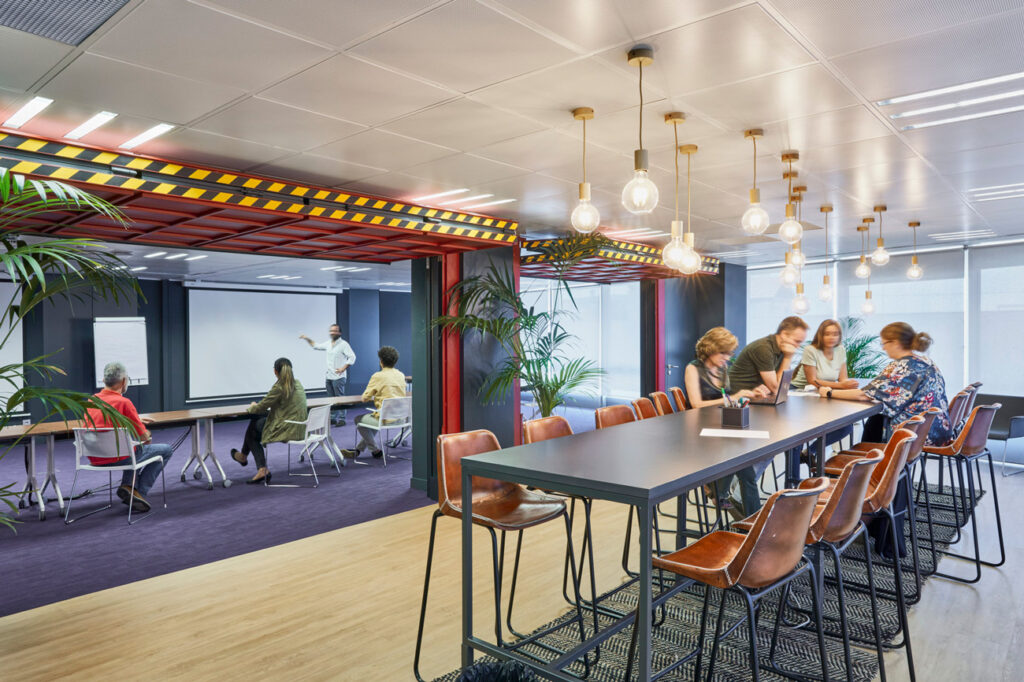
We have developed a cost model based on a notional fit-out for a space for 1,000 full-time equivalent staff, using a sharing ratio of 50 per cent.
You can read the full article and download the cost model here.
This is an abridged version of an article that was first published in Building magazine.
The post How carbon and wellness principles are driving office design appeared first on Without Limits.
]]>The post Assessing the cost implications of the upcoming Building Regulations revisions appeared first on Without Limits.
]]>Introduced by the Department for Levelling Up, Housing and Communities (DLUHC), the new regulations are primarily driven by the pursuit of the UK’s legally binding net-zero 2050 goal. The updated rules have also been influenced by the coronavirus, which has made clear the need for effective ventilation in buildings, particularly in high-density shared spaces such as offices.
These updates are setting the stage for larger changes in three years’ time. These uplifts are an interim – and preparatory – measure ahead of the much wider-reaching Future Homes Standard and Future Buildings Standard, which are due in 2025 and will apply to new homes and new non-domestic buildings respectively.
What will change?
The specific elements of the Building Regulations to be affected by the upcoming changes are Part L and Part F. Broadly speaking, Part L addresses carbon emissions and energy efficiency, while Part F is concerned with delivering good indoor air quality by delivering sufficient ventilation and minimising the ingress of external pollutants.
The headline element is the requirement for a 27 per cent average cut in operational carbon for new non‐domestic buildings (with a 31 per cent average cut for new domestic buildings). Thanks to increasing recognition of the need to reduce carbon emissions, some parts of the industry are already well prepared for the changes. The London Plan, for example, means that similar requirements to many of the changes introduced by the 2022 regulations are already in force. In the capital, it may well feel like business as usual for developers.
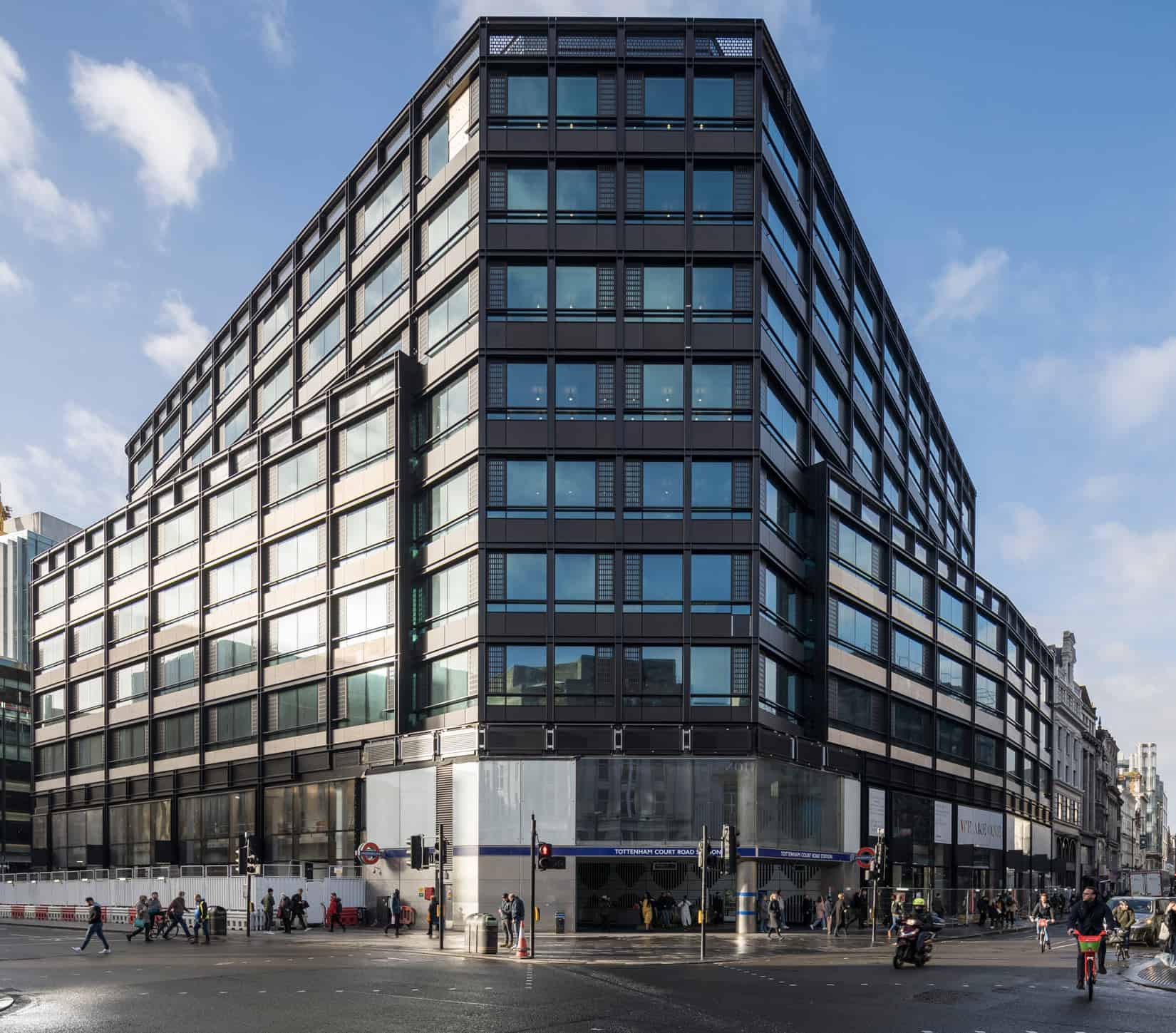
The design and cost implications
A flexible approach is essential to ensure the most effective solutions are found based on individual project constraints. Under the regulations, a theoretical ‘notional building’ is used to set a feasible target across different building types. The CO2 emissions and primary energy of any proposed building should be equal to or better than that of this notional building, which has the same size and shape as the proposed building, but is built to a standard ‘recipe’ of U-values and building service efficiencies.
The developer has the option to vary the specifications and relax some parameters relative to the notional building, as long as other parameters are improved beyond the notional specification, so that ultimately the CO2 emissions and primary energy are as good as or better than the notional building. This is intended to allow for flexibility – a mix-and-match approach, enabling certain design choices to be offset by other elements of the building.
Technological advancements and increases in supply chain capacity for more energy-efficient products have eased pressure on the cost of meeting the new regulations. For example, solar panels, LED lighting, and triple-glazed windows are all energy efficiency measures that are significantly cheaper today than they were in 2013, when the regulations were last updated.
The attractiveness of electricity as a power and heat source has also evolved. The carbon intensity of electricity dropped significantly over the past decade, in large part due to the rapid increase of renewable electricity feeding into the UK energy system. Building regulations previously favoured the use of gas as an alternative to electricity – a situation which the new rules reverse.
Looking to the future
The most important takeaway is that the new regulations are part of a wider shift towards highly efficient buildings where low levels of carbon – both from an emissions and an embodied carbon perspective – are the rule, rather than the exception. In adapting to the new regulations, our key advice is:
- Timing is important. The rules do not change overnight – this year, developers need to assess whether they will fall under the old regulations or must comply with the new.
- If developing a project that falls under the new Part L, then it is vital that the impact of this is considered at the earliest opportunity.
- The regulations are likely to drive a national shift away from fossil-fuelled heating towards heat pumps and other low carbon sources.
With the far more ambitious Future Homes and Future Buildings Standards set to go into technical consultation next year ahead of their introduction in 2025, the industry should aim as high as possible when designing out carbon, and is advised to drive up efficiencies and invest in innovation in order to remain compliant. As ever, it is best to be ahead of the curve rather than behind it.
Full cost model
We have built a cost model assessing the impact of the changes to Part L for three types of non-residential building: an out-of-town commercial office; a central London commercial office; and a large distribution centre. Analysis compared differences between notional buildings meeting the 2013 and 2022 regulations. You can read the full article and download the cost model here.
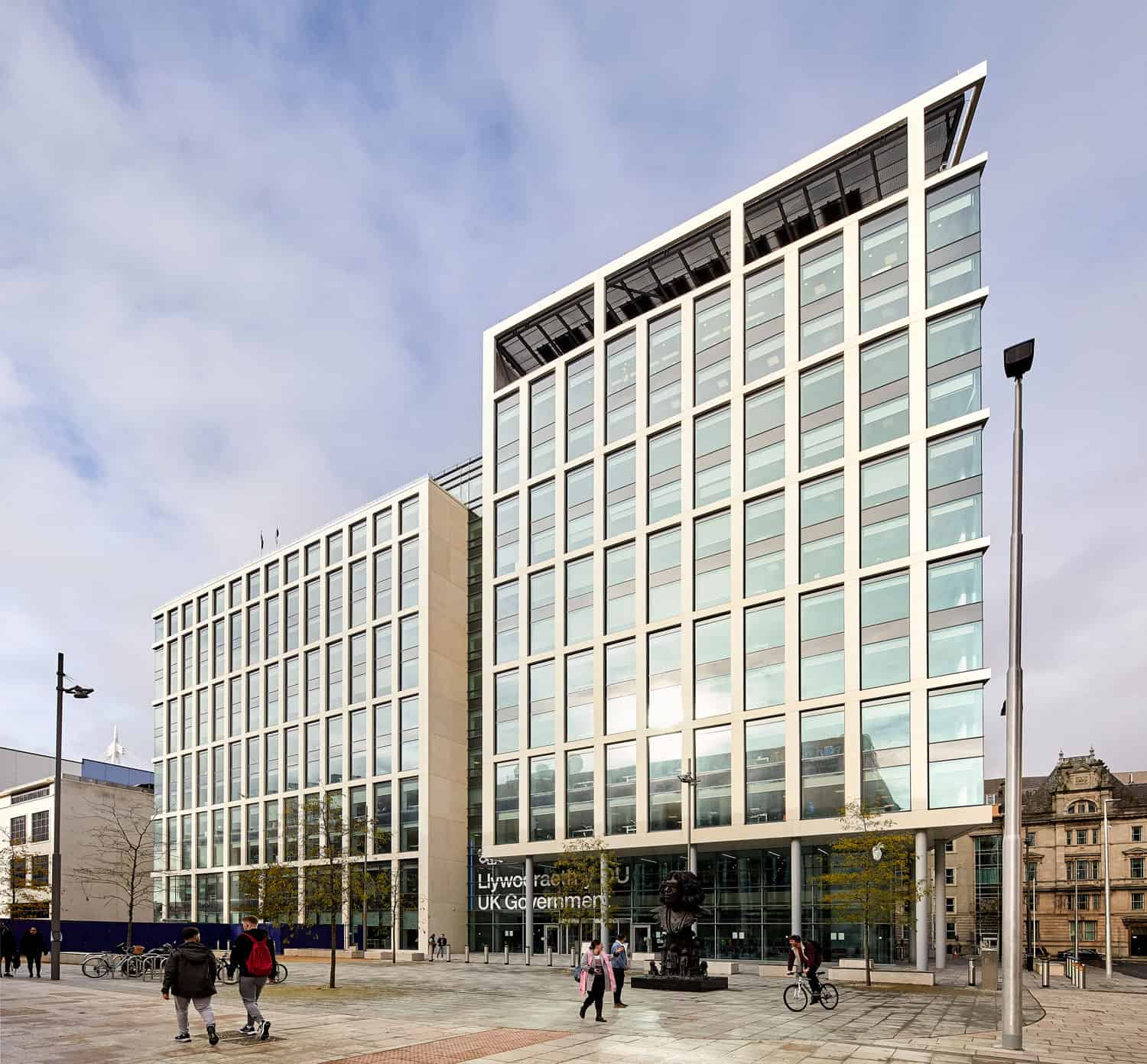
This is an abridged version of an article that was first published in Building magazine.
The post Assessing the cost implications of the upcoming Building Regulations revisions appeared first on Without Limits.
]]>The post Reducing operational carbon on commercial and educational campuses appeared first on Without Limits.
]]>Organisations, educational institutions, and companies with large campuses must decarbonise their real estate. In many cases, this is a complex challenge as each individual building – whether recently-built or 100 years’ old – must be made more energy efficient to reduce the amount of operational carbon used.
Historically, this might have been done on a project-by-project basis. To meet publicly stated climate emergency declarations and net zero carbon commitments however, organisations, institutions and companies will need to take a different approach, or risk reputational damage.

In this article, we argue the case for the adoption of a comprehensive decarbonisation plan on commercial and institutional campuses as the best way to reduce operational carbon in the most time and cost-efficient way. Furthermore, a comprehensive plan can also reduce reliance on increasingly expensive and bureaucratic carbon offsetting schemes.
1/ A piecemeal approach won’t cut it
Currently, there is a common knowledge gap between setting net zero targets and understanding what role decarbonisation plays on that journey, and how it can be achieved. Decarbonisation is not as simple as replacing gas boilers with heat pumps (as doing so greatly increases running costs). Instead, we strongly advocate that any action to reduce operational carbon by moving away from fossil fuels should be considered in the context of all ongoing maintenance and must touch all capital works.
2/ If you can’t measure it, you can’t manage it
Establishing a baseline for how well an estate is performing is the first step, along with general condition of the plant and fabric. If not already available (as part of either planned maintenance or maintenance backlog information), then an extensive survey will be required. Our Operational Carbon & Energy ANalysis tool (or OCEAN for short) gathers data on carbon and energy performance of individual buildings so that holders of large asset portfolios can understand how their entire portfolio is performing.
If not already installed, adequate metering is a good investment as it is essential to understand how an estate is performing to determine where or when to make interventions. Furthermore, once a solution has been implemented, it is equally important to then monitor performance.
3/ Make better use of space
Once a baseline has been established, the buildings and systems should be evaluated to determine whether space could be better used and/or operational hours consolidated.
In universities for example, where the pandemic has accelerated the trend to online study at home complemented by collaborative in-person sessions, the way space is used on campus has altered dramatically. Managed correctly, this is an opportunity to reduce energy demand by delivering learning in selected spaces that are shared between departments and faculties, and thus used more intensively. Similarly, the creation of night hubs allows parts of an estate to remain open out-of-hours while the majority closes.
4/ Develop a decarbonisation plan
The next step is to develop a decarbonisation plan for each building that considers fabric, lighting, controls, and plugged-in load. The plan should consider the opportunities for reducing operating temperatures to allow heat pumps to be used, and the possibility of using thermal storage. A decarbonisation plan needs to be built into the planned maintenance and plant replacement schedule along with an adequate budget commitment over the identified decarbonisation period.
Finally, each project needs to be delivered in sequence to ensure an institution can decarbonise in line with its publicly stated goal. Having switched to a lower energy approach with all electric services, organisations should subscribe to a certified zero carbon electricity tariff to complete the process.
Essential and achievable
Adopting a comprehensive plan to reduce operational carbon on a commercial or educational campus is essential – and achievable. In our experience decarbonising commercial and public real estate across the region, the most effective campus-level plans are informed by an organisational-level net zero transition plan. It’s the best way for firms and educational institutions to identify opportunities that save carbon, time, and money in the short and longer term, while providing assurance to stakeholders, customers and students.
The post Reducing operational carbon on commercial and educational campuses appeared first on Without Limits.
]]>The post Cutting the carbon in structural frames appeared first on Without Limits.
]]>In the race to meet net zero by 2050, there is positive news for those working in the built environment – operational carbon emissions in the sector have dropped significantly in recent years. This is because better technology is creating energy efficiencies, but it’s also happening because both government and industry have taken operational carbon emissions seriously.
In contrast, embodied carbon is much harder to quantify, and has suffered from a lack of consistent benchmarking, research and data. This lack of reliable information has made it tough for government to set informed, regulation-backed, reduction targets. However, as embodied carbon’s share of total carbon output expands, and operational carbon continues to shrink, this will soon change, making it important for developers to be ahead of the curve.
Digital tools will be key to quantifying embodied carbon
The structural frame of a building is one of the biggest sources of embodied carbon in a building: reducing this carbon therefore needs to be centre stage and influence every decision made in the design and construction process.
For industry, the ability to swiftly and accurately assess the embodied carbon impact of a wide range of structural options will be essential to achieve genuinely low-carbon or net zero buildings. However, there are often wide variances in knowledge, experience and awareness of embodied carbon across different clients and design teams. That’s why the creation and implementation of digital design tools from the earliest conceptual stages of a building are going to become increasingly valuable and critical.
Doing this effectively requires access to real-time data to immediately demonstrate the carbon and cost implications of design options – we have developed the Eco.Zero digital design tool to enable this process.
digital design tool to enable this process.
Cutting embodied carbon: a complex, multifaceted task
Whilst the embodied carbon of the frame and substructure is significant in itself, it also interfaces with a multitude of other systems – façade, partitions, finishes and services, for instance. These systems all interact, so to offer a true reduction in environmental impact we always advise a holistic approach to early stage life-cycle carbon assessments.
For example, column-less floorplates are currently desirable, but need much deeper spans of steel to counter vibration frequency – adding carbon and cost to the design solution. Materials also present a balancing act. Brexit has impacted on the cost of importing lower-embodied carbon materials, such as European electric arc-furnace produced steel. The obvious answer is to use local, home-grown materials instead – yet this can also have negative impacts on the carbon profile of a project. The UK may have its own home-grown steel supply, but 80 per cent of it is produced in coal-fired blast furnaces, which emit higher levels of carbon.
Therefore, when assessing the embodied carbon footprint of a structural design, a whole-life approach which identifies all potential carbon emissions, at all phases of the eventual building’s life – from the pre-construction phase to decommissioning – should be used. It’s a tall order, and one that is best done at the earliest stages of the project, when the ability to influence the design and maximise whole life cycle carbon reductions is at its greatest and the cost in doing so is at its lowest.
Where we’re headed
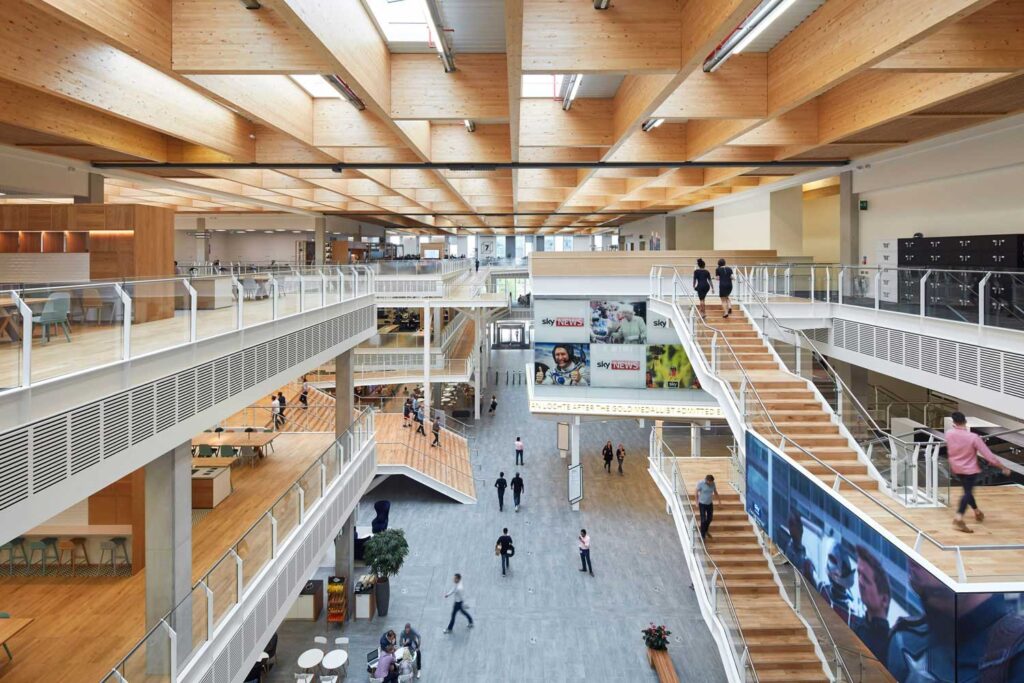
Despite the challenges, the industry can no longer ignore the issue of embodied carbon, nor can we work in silos when it comes to reducing it. We all need to be on board – carbon needs to be considered right from the outset as a core part of the building’s design, purpose and value.
There is no one-size-fits-all option, no perfect material or design that is inherently the best option from an embodied carbon and cost perspective. Instead, decisions have to be made on a project-by-project basis, incorporating as many variables and considerations as possible and making the most of the technology and data that is available to us at present.
The availability, quality and interoperability of embodied carbon data will make a huge difference to the pace at which we progress in reducing embodied carbon. We’re in the infancy of having widespread access to reliable, comprehensive carbon data across all elements of a building, which will allow developers to make smart, informed choices.
As embodied carbon in buildings becomes more and more understood and recognised, right now, the most effective solution to reduce it is to deploy the best of emerging data and materials technology – whilst also staying mindful of time-honoured techniques of being frugal and thoughtful with materials use, designing with simplicity and functionality at the fore.
Comparative cost and carbon model
We have built a comparative cost and carbon model have been made of the following frame types: reinforced concrete flat slab; composite rolled steel with metal decking, steel frame with cross laminated timber slabs and a cross laminated timber, glulam and steel column hybrid. Models are based on a new build commercial office building in a central London location with a gross internal area of 10,500m2.
This is an abridged version of an article that was first published in Building magazine. Click here to read the full article and download the cost model.
Additional contributions from Jack Brunton, David Wong, Colin Campbell and Kelly Forrest.
The post Cutting the carbon in structural frames appeared first on Without Limits.
]]>The post The delivery of affordable housing in Ireland needs to be accelerated appeared first on Without Limits.
]]>Coming out of the pandemic, Ireland’s housing crisis, north and south, cannot be ignored. Yes, the possibility that more people will work, more often, from home opens exciting possibilities for different types of living away from urban centres, but our key workers must still be able to get to their jobs from affordable homes near suitable transportation.
And both the Republic of Ireland and Northern Ireland have a critical lack of affordable housing. By March 2019, there were 37,859 applicants on the social housing waiting list in Northern Ireland, of whom 26,387 were in “housing stress”. Resolving this is a key focus for the Northern Ireland government, with Belfast 2035 growth plans targeted at delivering 32,000 new homes. It is also a priority for the Irish government, with Project Ireland 2040 including plans to increase overall housing supply by 25,000 homes a year by the end of 2020, and then 30,000-35,000 annually up to 2027.

It will not be easy for public bodies to overcome their struggles in delivering housing. But these housing goals are a start, and by working closely with experienced project managers and using the full range of resources and consultants available, there is a way to achieve them. Moreover, a new approach to public transport and compact urban development could allow for housing to be better targeted in a joined-up approach that is badly needed. Project Ireland 2040 is demonstrating the right approach to rail and housing by aiming to secure over 50 per cent of future housing needs in existing built-up areas.
Procurement and planning must be streamlined
From the outset, the procurement process in the Republic of Ireland is complex and time-consuming. In the UK, established design team frameworks enable a streamlined procurement system for developing a brief, a business case or a feasibility study in a matter of weeks. In the Republic, that process can take months.
The planning process itself can also be slow, expensive and risky. Whilst changes in planning legislation to allow major housing developments go directly to the planning appeals board has brought more definition to some elements, the changes have also led to a steep rise in demands for judicial review. Given that a judicial review can take two years to proceed, this can seriously frustrate the planning process.
A Housing Task Force could resolve these issues, with a focus on project management, including both public and private sector team members. In the Republic of Ireland, there are many different agencies involved in the development of a single affordable residential scheme (starting with local authorities, An Bord Pleanála, Irish Water, Environmental Protection Agency and the Department of Housing, Local Government and Heritage), with each agency working to its own timescales, priorities and budgets. An empowered overarching Housing Task Force could focus on delivery and move blockers.
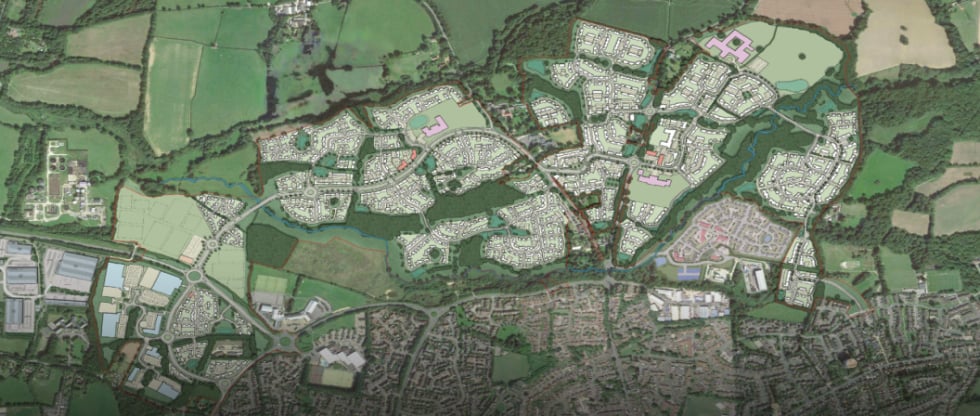
In planning, it is vital to keep the process moving, resolving bottlenecks and ensuring that an application doesn’t get stuck on someone’s desk. At AECOM, we have seen plenty of instances where good project management has helped with large-scale planning applications and streamlined processes. In Burgess Hill in southern England, for example, we are the lead consultant on the Northern Arc project, a major development being promoted by Homes England, that will deliver up to 3,500 new homes. Using our Masterplanning IE technology-based approach we achieved local authority approval for the masterplan and infrastructure delivery plan in under four months. Outline planning permission with a signed legal agreement was achieved in 16 months.
This accelerated programme was made possible by stakeholder co-operation and the creation of a masterplan that was supported by the gathering of all the necessary technical evidence. For example, flood risk and drainage technical expertise was deployed from the very start of the project. This allowed sustainable drainage systems to be integrated into the masterplan, mitigating the impact of climate change on fluvial flooding. A problem that might have reared its head after months or even years of planning work was resolved from the outset.
“In planning, it is vital to keep the process moving, resolving bottlenecks and ensuring that an application doesn’t get stuck on someone’s desk.”
Managing viability issues
In both Northern Ireland and the Republic, there are issues around the financial viability of projects. Even with planning permission achieved, the projected cost of development can wipe out a positive return from potential sale or rental revenues. Less than 30 per cent of projects granted planning permission through the Strategic Housing Development planning route have commenced on site.
Assessing viability has also been made more complex by the pandemic. Developers are having to work out whether more working from home is a long-term trend or whether people will return to the office within months. Making long-term decisions that will affect people for decades is a challenge when there are so many moving parts. An effective Housing Task Force would help address these viability issues.

Either way, it is likely that some workers will embrace home offices, and there is also a growing awareness that daily long-distance commutes are not environmentally desirable. Essentially, developers have to find a way of creating financially viable new homes close to urban centres for keyworkers while also finding a way to accommodate people who are able to live further away from their workplace.
One way of accelerating the development of affordable housing is to further explore the options for state-owned land that could be suited to quick development. This is advancing quickly with the establishment of the Land Development Agency in the Republic. The state land portfolio includes many sites with viability challenges. The challenges range from utility infrastructure deficits to significant protected structures including historic health and defence buildings. At face value, the development of these sites may seem challenging, but when broader economic benefits as well as the carbon benefits of retrofit versus new build and the long-term cost of the ‘do nothing’ option are considered, the argument for development is compelling. The AECOM Economics team has developed models for taking a broader view on such developments.
Resolving obstacles to implementation
After planning and viability comes actual implementation, and there are major challenges facing the Irish construction marketplace today. The industry lacks the resilience and scale needed to invest in modern methods of construction that are cheaper and faster, and reduce the carbon footprint of developments.
Government support could aid such innovation, as without it, the implementation of major schemes is very difficult. For the construction industry to grow as required, the government needs to establish a pipeline of upcoming work for those prepared to invest in their methods and materials. The key priority must be to develop effective masterplans that accelerate and improve every element of property development, enabling smooth implementation of affordable housing developments.
“The key priority must be to develop effective masterplans that accelerate and improve every element of property development, enabling smooth implementation of affordable housing developments.”
Affordable housing is too serious a problem to be allowed to drift on. The challenges faced by public bodies charged with delivering affordable housing are significant and public bodies often lack the expertise and experience to deliver the quantity of housing necessary in a relatively short period. But there are projects such as Burgess Hill that demonstrate a way forward, showing that the harnessing of the vast range of skills and resources available in the private sector can lead to effective collaboration and progress.
The post The delivery of affordable housing in Ireland needs to be accelerated appeared first on Without Limits.
]]>The post Improving data centre delivery through an integrated approach appeared first on Without Limits.
]]>Described by some industry commentators as the ‘new oil’, data is expected to increase 10-fold worldwide between 2017 and 2025, with 75 per cent of the global population interacting with data every day, according to International Data Corp. Driven by the growing use of mobile technologies and cloud computing by both businesses and consumers, this relatively ‘new’ global data industry is growing — and fast.
New investment opportunities
To cope, more data storage space is needed. This has led to a boom in data centre construction, bringing about significant opportunities for further investment in this alternative but growing asset class — globally, data centre construction is set to expand by more than 8.24 per cent to US$32.37 billion (€29.04/£25.5 billion) between 2018-2025. For example, in the Middle East alone, rapid digitisation of ‘smart cities’ is spurring the data centre market, which is expected to grow annually by 7 per cent between 2018-2024.
Growing demand
To keep up with demand for ‘white’ or data storage space, the data centre industry is under pressure to bring resilient, efficient and secure infrastructure and facilities to market quickly. In response, hyperscalers and operators are increasingly looking to complete site selection, acquisition, design and construction work as efficiently and innovatively as possible.
Integrated data centre delivery
We believe it is possible for the industry to increase speed to market through integrated, multi-disciplinary delivery across a data centre’s journey to completion.
Inception – Selecting a suitable site with appropriate power and utilities is fundamental in getting projects off the ground. Our integrated approach starts from project inception with site selection, masterplanning, environmental screening and planning permissions. Our planning experts share their in-depth knowledge and experience of navigating the complex data centre planning process with our designers to ensure designs meet essential requirements needed to obtain permission.
Design – We develop design briefs collaboratively with clients and appropriate stakeholders. Working as a single, multi-disciplinary team enhances collaboration, driving faster delivery through seamless and efficient handover between disciplines. This ensures a flexible, resilient design that fits with the client’s requirements to ultimately satisfy their end customers more efficiently.
Delivery – Working closely with the client, our integrated team of architects, engineers, environment and planning specialists share knowledge of the various customer, planning and construction requirements to achieve a better, more adaptable solution. Our construction related services including on-site environmental monitoring, project management and cost consultancy ensure projects are kept on the right track, through to client handover.
Data centre delivery in the Middle East
AECOM was engaged by a global corporation to design new build data centre campuses on three sites in the Middle East.
Our specialist UK and Ireland Centre of Excellence data centre teams collaborated with local in-country offices on the due diligence process for an initial critical load of approximately 4MW per data centre complete with a shell and core suitable for 15MW, as well as an overall masterplan of 90MW per site.
During the design stage, which was achieved in five months, a significant value engineering exercise was completed to offset the impact of increased cooling loads resulting from the high local temperatures.
As a result of effective engagement with local statutory authorities, all planning, building and utility permits were successfully obtained and AECOM was subsequently retained to provide construction supervision services to the client’s construction management team.
The depth of specialist data centre design knowledge held within our Centre of Excellence data centre team, coupled with the in-country teams’ local knowledge that helped coordinate the permitting process, was key to the successful delivery of this project, with all parties recognising the importance of seamless communication throughout the design and construction phases.
Furthermore, we supported the local construction team throughout the build, ensuring any on-the-ground design changes were controlled and complied with the overall base design.
The benefits of an integrated approach
Improves information transfer: Integrated working reduces the risk of information being lost between disciplines/organisations, due to fewer interfaces. This is particularly relevant during the data centre design permitting process when the feedback loop between environmental and planning specialists and designers is continuous, producing updated versions of reports or further iterations of design, requiring a high degree of collaboration.
Streamlines communication: Data centre clients receive a single point of contact, as opposed to several, streamlining all communication, from daily and weekly progress and coordination meetings to engagement with the local authorities.
Drives overall efficiencies: Procuring and managing just one entity drives overall savings and greater efficiencies through reduced administration. It also avoids duplication of efforts and resources as well as the untimely coordination of interfaces.
The post Improving data centre delivery through an integrated approach appeared first on Without Limits.
]]>The post Going underground: untapped land uses beneath our feet appeared first on Without Limits.
]]>While Hong Kong has a long history of using underground space for commercial and public facilities, many of these projects were simply an extension of the building on top of them, with limited connection to the city around them. As urbanization continues its upward trend and our perceptions of space — personal and public — are constantly evolving, this use of layered technologies to explore the underground holds the potential to revolutionize urban liveability and create synergies with the surrounding urban context.
AECOM, commissioned by the Civil Engineering and Development Department (CEDD) of the Hong Kong Special Administrative Region (HKSAR) Government to undertake a study of underground development in an urban space, has explored ways of integrating the latest innovative technologies, including Virtual Reality (VR) and photogrammetry technologies with more widely used techniques in the industry, such as Building Information Modeling (BIM) and 3D spatial data to improve communication among the different parties involved in the planning and design process of underground space.


This novel combination of technologies has resulted in time savings, increased efficiency and cost benefits as well as greatly enhanced cooperation and the ability to virtually collaborate without the need for travel to a project site. On one project, outlined below, the use of photogrammetry technology to create a 3D model of the existing site saved three weeks time from the site survey, while sharing the site reality model with the designer for performing the parametric design saved another two weeks. Integrating various feature models into a visualization model for the Virtual Reality simulation saved another two weeks by amalgamating information to form a holistic review with different parties. Further, it saved client comment time as 3D visualizations facilitate the design detail and constraints of the project. Since the design team did not need to travel to Hong Kong, this saved around $100K HKD.
Particularly in high density cities, where land value is high and greenfield developments are hard to come by, the ability to map the underground more effectively and efficiently may open a world of possibilities.
This combination of technologies was first used to see how an urban park in Honk Kong that is close to a railway station could be better integrated to its surrounding area. The park is surrounded by densely developed multi-story buildings of mixed residential, commercial and retail use. For initial planning, AECOM and CEDD wanted to capture the existing environment in a 3D model to study how the park related to a wide range of facilities at ground level. But while there was 3D data on the buildings surrounding the park, there wasn’t any available 3D data on the park itself. That’s when we started going underground.

To build a more complete picture, we used Hong Kong government 3D spatial data[1] from the Lands Department to create that 3D model of the park then combined it with aerial photogrammetry technology. We shared the resulting model – complete with hard and soft landscaping and areas of interest within the park – with our partnering architecture design company based in Japan who had enough detail to be able to do many things that would usually have required travel to Hong Kong. This included measuring the space, seeing the topographic setting and the detail of the proposed site, as well as gaining an understanding of how the underground project would relate to the existing environment.
In the early stages of the design, a BIM model was created using the architectural design model which allowed all parties involved to communicate effectively and with a great level of detail. The BIM model was then combined with the site reality model (3D + photogrammetry) to create a Virtual Reality (VR) model that could be experienced on a computer screen. This virtual environment gave designers, planners, engineers, consultants and client representatives a realistic and life-sized place to walk and talk through the various aspects of the project.
After we layered on the virtual reality component, the resulting 1:1 representation of the project site also enabled 360-degree panoramas suitable for mobile VR devices used at in-person public consultations, as several mobile devices can be deployed at one venue. Panoramas can also be hosted on a website to reach a wider audience. The next level we’re exploring is a computer-connected VR device which would allow for more detailed design review and for users to interact with the virtual underground space design at a real-world scale. These representations could also be used in a virtual consultation room using AECOM’s interactive web-based tool.
Another benefit to this layering of technologies is that visualization models are not limited to the illustration of design details; data can be converted to other software to view shadow, noise and traffic impact assessments; 4D (BIM) simulation can also help to visualize the construction process.


This approach is unique because the novel integration of these innovative technologies has rarely been investigated within the framework of a single project and never-before used to explore underground space. Stakeholders often think only of BIM, but with an open mind this concept can be (and has been) replicated with different combinations of the various available technologies to suit the needs of other clients and projects.
Our study demonstrates the clear benefits for all parties involved in the planning and design of the conceptual scheme for underground space development in densely populated urban areas. Designers, planners, clients and consultants can visualize the components of a design at a 1:1 scale in ways that cannot be matched by 2D or 3D software alone. For the public, the realistic nature of the VR-based model brings the project and its full potential to life.
Learn more about this and other explorations of the potential of subterranean space to revolutionize the future urban experience in the new book Underground Cities: New Frontiers in Urban Living, introduced here.
AECOM would like to acknowledge the Head of Geotechnical Engineering Office and the Director of the Civil Engineering and Development Department, the Government of the Hong Kong Special Administrative Region, for the permission to publish. The usage of material was authorized by ACUUS, the Associated Research Centers for the Urban Underground Space. The Government of the Hong Kong Special Administrative Region does not accept responsibility for the accuracy, completeness or up-to-date nature of any reproduced versions of the material concern.
Unless otherwise indicated, the photographs found in this article are subject to copyright owned by the Civil Engineering and Development Department (CEDD). Prior written consent is required for a third party who intends to reproduce, distribute, display or otherwise use such photographs in any way or for any purpose. Such request for consent shall be addressed to the CEDD via email at enquiry@cedd.gov.hk
[1] 3D Spatial Data is a set of territory-wide digital 3D model data created to represent the shape, appearance and position of various types of ground features including building, infrastructure and terrain.
The post Going underground: untapped land uses beneath our feet appeared first on Without Limits.
]]>The post Surplus office space to cutting-edge laboratory: three refit considerations appeared first on Without Limits.
]]>The UK’s Life Sciences sector is a national success story. It supports almost a quarter of million jobs and generates £70 billion in economic value, and it is growing – fast.
This growth is in part thanks to historic – and continued investment. In the Spring 2020 budget, the government announced a commitment to doubling the amount of funding to Life Sciences. The sector is also in the spotlight as numerous organisations, from global pharmaceutical companies, to the Department of Health, Public Health England, academia and science parks collaborate on a vaccine against coronavirus. These efforts have also been backed by government, which has pledged tens of millions of pounds to scale-up research, particularly among start-ups.
This combination of factors means that the demand for suitable research and development facilities is rising exponentially, as there was a shortfall of space even before the current pandemic. Whereas constructing newly built premises is slow and carbon intensive, refurbishing existing office space offers a faster and more efficient solution. It’s a golden opportunity for commercial developers and public sector bodies to re-evaluate their existing assets to meet that demand, one that has the potential to deliver higher rental returns.
In this article we examine Life Science sector needs and why it is good time to repurpose surplus sites. We also share three considerations that asset owners can make when examining real estate portfolios.
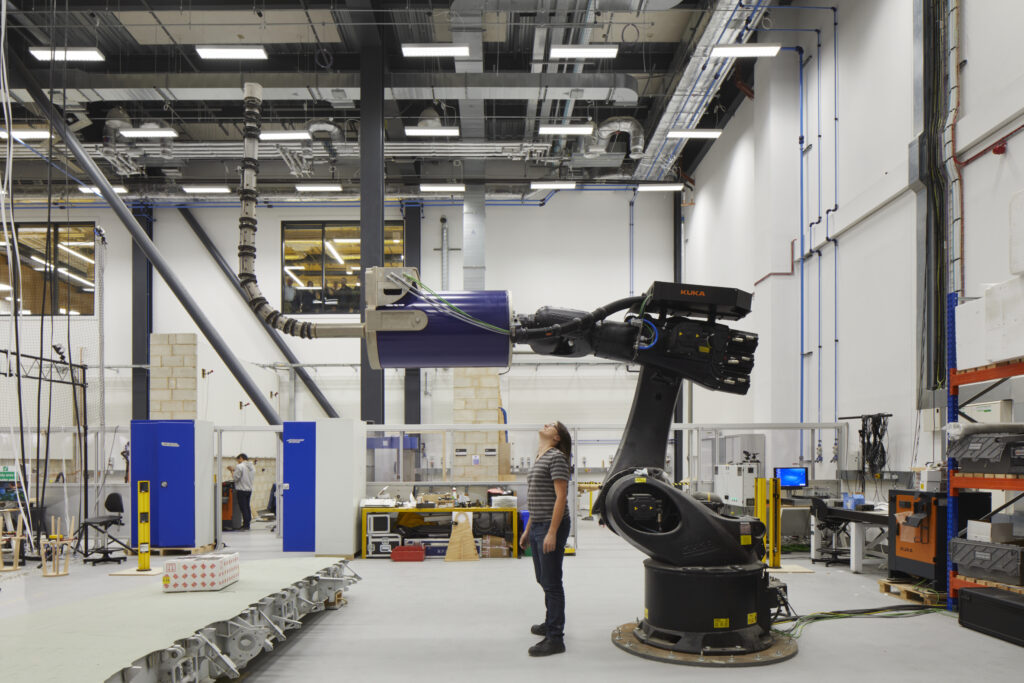
Understanding sector needs
So, what exactly is the Life Science sector looking for? For most the answer is location, location, location. As traditional science disciplines blend with tech and digital science, life science companies are increasingly seeking out premises in areas where Innovation Districts are either established or emerging.
According to laboratory fit-out specialists Galileo Labs, “The nature of life science research is shifting to a collaborative model where co-location and open and accessible facilities for smaller science companies is required. Combining the academics with clinical staff as well as research and development (R&D) partners creates a unique ecosystem, making property in the area extremely sought after.”
With continued investment in rail infrastructure, Cambridge and London connectivity is supporting the growth of these life science/healthcare ecosystems, alongside Oxford, with activity in the capital centred round the Knowledge Cluster at King’s Cross/Euston as well as Imperial College’s Innovation District at White City. Other key areas in the UK include Alderley Park near Manchester, Innovation Birmingham near Aston University, and Edinburgh’s BioQuarter. Across the water, Belfast and Dublin both have thriving Life Sciences clusters, particularly with the convergence of technology and life sciences .
The UK is still adjusting to new remote working practices in relation to coronavirus, but the sector is very limited in terms of what can be done outside the laboratory environment due to the need for sterile spaces and the increasing use of artificial intelligence to process vast data sets at speed. Demand is therefore growing for a range of accommodation from small labs for start-ups to larger combined laboratory and office space for more mature businesses.
Crucially, life science companies are also moving more towards enhanced office environments with smaller areas of wet/dry lab content, as traditional analysis methods are being replaced by smart, advanced technology. This is good news for those looking to repurpose existing facilities because less floor space needs the structural and services modifications to accommodate wet/dry lab areas.
However, no matter what the size or type of accommodation, co-location remains a key draw.
Repurposing existing space can meet demand
The UK has significant unmet property demand for small and large purpose-built science space in key locations. Public sector organisations looking to improve or relocate well-located parts of their estates while at the same time disposing of more obsolete sites are in a strong position, particularly if they consider working with commercial partners.
Repurposing an existing office block (or other space) with the right design parameters for laboratory use is advantageous in many ways. The representative rental values in London for laboratory space can range between £70 – £125 per sq ft compared to those for office space which are £57.50 per sq ft, according to Galileo Labs.
From a sustainability perspective, refurbishment can deliver a 56 per cent reduction in carbon emissions compared to a new build facility – giving lab space strong eco-credentials that may be attractive to prospective tenants. Aside from sustainability, there are significant gains in terms of speed to market. In addition, refurbished space can be flexible enough to accommodate multi-tenant start-ups right up to more established operators, who may wish to rent entire floors.
Here East, formerly the Media Centre for the 2012 Olympics, is a good example of an innovation and technology campus for start-up companies. Granta Park, a science park in Cambridge, has also undertaken studies into repurposing its existing space.
Three considerations
Here are three considerations when refitting space to a laboratory environment:
1/Consider slab heights and risers
An initial viability needs to quickly determine the slab-to-slab height of a building to establish whether there is enough height to bring in additional services, such as risers. Typically, a lab storey height would be 4.1 to 4.5m high (top of slab to soffit) allowing for the vertical distribution of air across the floor plate, compared to an office which is more likely to be 3.6m to 4.2m. Older properties such as telephone exchanges, banking halls and financial institutions generally lend themselves to this configuration, due to their dense frame and generous storey heights. Equally, warehouses, industrial premises and even shopping malls could be considered.
A solution to lower storey height buildings is to create greater density of internal risers and plant room space.
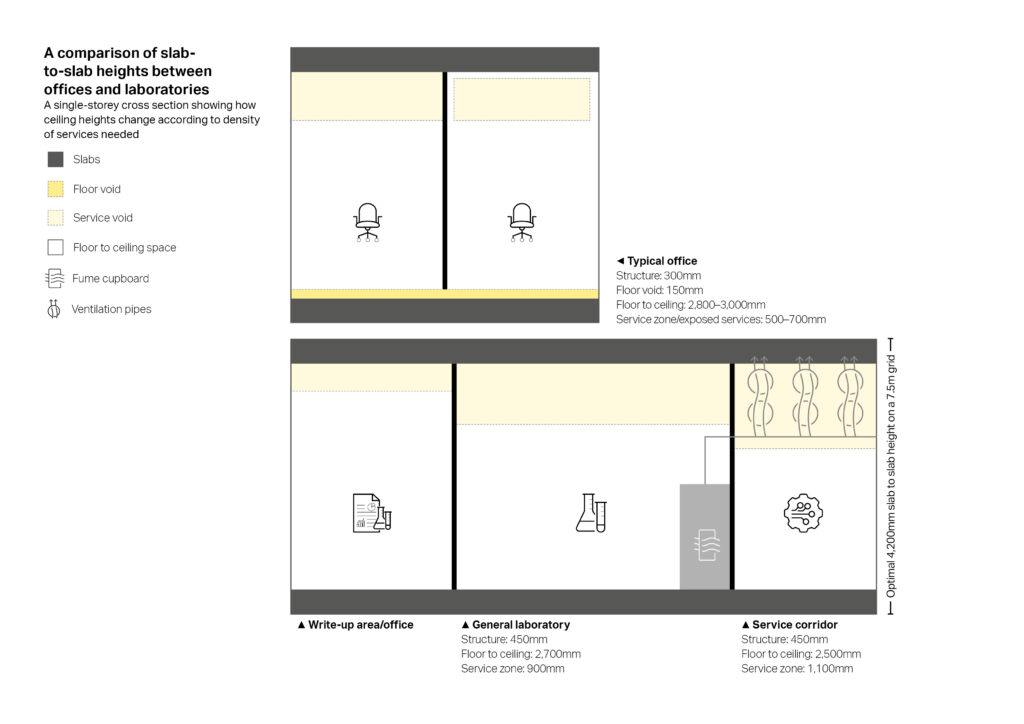
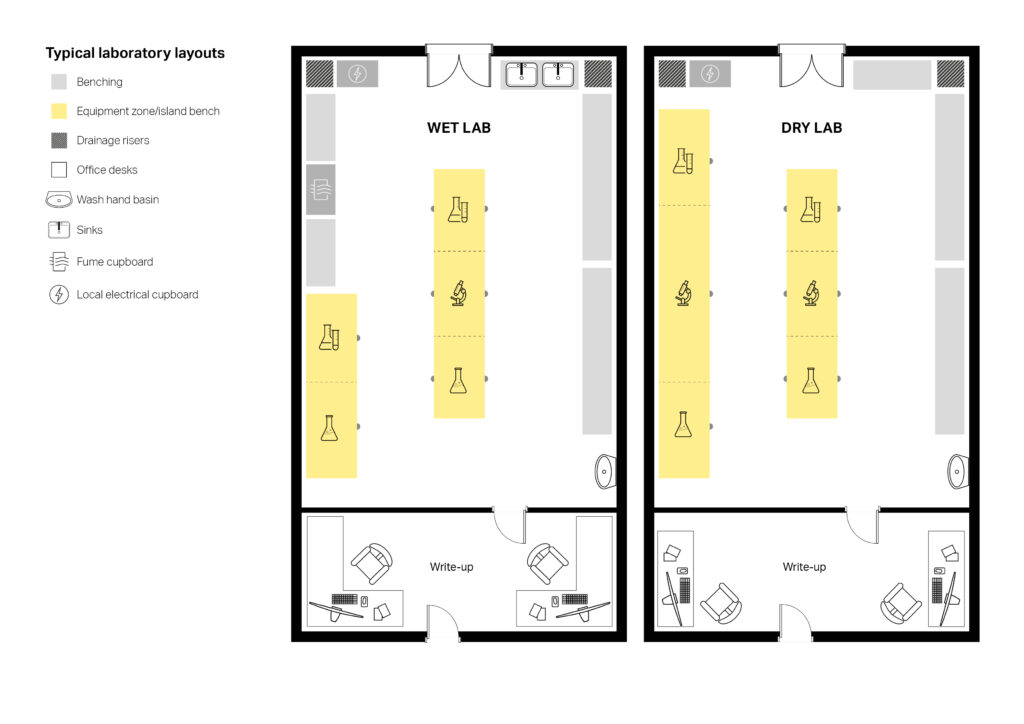
2/Take advantage of financial incentives
There are specific tax benefits associated with research and development (R&D). The capital cost of construction works to create dedicated research facilities for owner-occupiers benefits from 100 per cent capital allowances. Any innovative design or construction solutions to overcome site-specific scientific or technological uncertainties may qualify for R&D tax credits. These provide an enhanced (or super) deduction of 230 per cent for eligible staff costs for SMEs, or a 13 per cent ‘above the line credit’ for large companies.
3/Factor in wellbeing
Facilities with roof terraces and other recreational zones will be highly sought after, especially in urban areas. Scientists work in controlled environments so break out areas such as wellness/contemplation rooms and outside spaces will be in demand. These spaces can also be safely adaptable to serve a variety of functions in line with government distancing guidelines.
A golden opportunity
The case for refurbishment has never been stronger, and not just because it is a low carbon alternative to building new premises. It is also cost-effective and has the benefit of faster speed-to-market delivery, as well as being an opportunity to unlock assets in high-demand locations.
More space is clearly required to enable the life science sector to grow and refurbishing existing assets can help meet the demand for well-located, well-equipped laboratory space, while providing healthy returns.
The design and construction industry still has some way to go in communicating and demystifying the office-to-lab refurbishment process and increasing awareness amongst asset owners that they have a golden opportunity to maximise their underutilised or poorly performing assets. However, the case for office to laboratory refurbishment is strong and, as a result, we expect confidence amongst asset owners to grow.
With thanks to AECOM’s Josh John, Senior Project Surveyor and Lewis Peacock, Associate for their contributions to this article
The post Surplus office space to cutting-edge laboratory: three refit considerations appeared first on Without Limits.
]]>The post What to look for when considering modern methods of construction appeared first on Without Limits.
]]>In 2019, the Housing Communities and Local Government Committee clearly stated that “a significant proportion of homes must be built using modern methods of construction (MMC) if we are to meet the target to deliver 30,000 homes annually.” Developers, contractors and design and engineering consultants, have responded to meet demand with an array of solutions and products – from refurbished sea containers to fully customisable modules. The result is a transformation in the way that we deliver the UK’s housing stock.
Local and city authorities, developers and housing associations are gradually embracing the idea of using these new construction technologies for use on their developments. The next step is choosing the right solution for the project and wider community – an understandably tricky ask when we remember that these construction technologies are relatively new and the pros and cons of each are not always apparent.
The way forward becomes clearer when we ask: what ambitions can a given modular or offsite solution meet not only for the specific project but for the wider community as well?
Adoption in the UK
The £72 million investment injected into the Construction Innovation Hub by the UK government in 2018 to promote the development of digital and advanced manufacturing is paying off. Advances in Building Information Management (BIM) and generative design software are accelerating the adoption of manufactured offsite solutions. Supply chains are maturing in response and are better integrated at the design stages. There has also been an uptick in manufacturing expertise within the construction sector. Hesitancy and concerns around higher costs are shifting as these construction technologies become more widespread and cost effectiveness continues to increase.
As more options come to market, the benefits in terms of cost savings as well as the reduction time in the design and construction phases by up to 50 per cent compared to traditional build methods, are being realised by authorities, developers and housing associations, especially in the context of meeting the UK’s ambitious housing delivery targets.
Government agency Homes England has been an earlier adopter. Modern methods are being used to construct 1,500 homes across the country. Homes England has just commissioned a research study to test these emerging construction technologies on its sites and it’s hoped that the results will further encourage uptake of MMC in housing delivery by providing verifiable performance data to inform future decision making.
Decisions should be guided by data, but it is important to also consider how certain attributes can inform project-specific and community-specific ambitions, for example how net zero homes can contribute to a borough’s wider carbon reduction targets or whether a solution is flexible enough to fit a site’s constraints.
Three factors that should guide decision-making
Below, we explore three factors that we think decision makers should consider, and give advice on how to achieve these outcomes.
1/Quality and the importance of the ‘MMC mindset’
The prefabricated homes from the 1950s and 60s have cast a long shadow over the reputation of modular housing. Preconceptions around ‘box’ standardisation, bland exteriors and poor standards of insulations and finishes still linger. However, today’s architects are using modern construction technologies to produce end products that are far superior – and much more flexible.
Good design delivers high quality living spaces. Modern solutions can be adapted to maximise the number of homes on a site, deliver different space standards and support a wider range of tenures. External elevations can be chosen to complement the vernacular.
To best achieve these outcomes however, it is critical that a fully integrated team – from the clients and the design consultants, through the supply chain and construction teams – comes to the table from project kick off to agree and sign off on elements such as space, materials and intended use prior to production. This process requires a complete change of mindset that is radically different from traditional ways of working.
2/Take a fabric-first approach to deliver low carbon homes
Decarbonising the UK’s housing stock is a significant slice of the strategy needed to meet ambitions to reduce net greenhouse gas emission by 100 per cent by 2050. This means addressing operational and embodied carbon.
Design innovation and technological solutions are helping to bring about behavioural changes to lower carbon emissions. Building for 2050, a research programme led by AECOM and funded by the Department for Business, Energy and Industrial Strategy is identifying the drivers, demands and challenges to delivering low carbon homes. If we are to meet net zero ambitions however, an MMC fabric-first approach – i.e. maximising the performance of individual components and elements – is essential. Solutions that identify fabric-first factors such as insulation, airtightness, ventilation and thermal bridging and solar gain will inherently deliver low energy homes with reduced running costs.
3/MMC solutions can be leveraged to make a positive local impact
Social value has risen up the political agenda since parliament passed The Public Services (Social Value) Act in 2012. The UK2070 Commission’s report lays out plans to ‘level up’ regional inequalities across the UK, although it is light on detail. Nevertheless, on a local level, boroughs and councils have successfully implemented social value into their procurement processes.
The skills required for MMC differ from those used on a traditional construction site. Some modular system manufacturers provide on-site training and employment opportunities for the local workforce.
For example, AECOM and RSHP’s INNO offsite volumetric system is a solution which can be fully localised, unlocking employment and training opportunities in the community, local authority or city. Working alongside the INNO central assembly site in Nottinghamshire – otherwise known as the Centre of Excellence – satellite assembly units can be set up near or close to project sites. INNO works with local authority organisations or institutional associations to employ and train local people to help deliver the high-quality homes.
The importance of an MMC-mindset
Clearly, emerging construction technologies have potential to add value to an individual project and the wider community – and these attributes can inform the decision-making process.
To maximise that value however, traditional ways of working must be put to one side and a radically different mindset employed. Clients, design consultants, the supply chain and construction teams need to work together from the outset as an integrated team to get the best results. Delivering homes of a high quality must always be the priority.
Case study: YMCA Romford and INNO
Adopting the INNO solution – an offsite volumetric housing system by global engineering firm AECOM and world-renowned architects Rogers Stirk Harbour + Partners – the 39 one-bedroom units at YMCA Romford are helping residents take the step towards independent living.
The fabric-first approach to the design has delivered high quality and high performing homes which reduce the running costs for residents by 90 per cent and meet PassivHaus standards.
Working with INNO’s integrated design, manufacturing and assembly team, the YMCA adopted a MMC mindset that resulted in a clear design direction and an efficient delivery programme. As part of the process, a 1:1 digital model was produced and a prototype unit delivered prior to the production kick off, minimising snagging and defects to almost zero. These measures helped YMCA Romford make up to £250,000 in savings across materials, assembly and programme.
Steve Brightwell, Executive Director of Oerations at YMCA Thames Gateway commented: “At YMCA Thames Gateway we are committed to supporting our residents to move their lives forward, which ultimately means living independently. The challenge of providing high quality housing – that remains affordable – is well documented; and a key driver for us opting for the modular solution. Our new 39 units will provide young people with the incentive to become more independent whilst benefitting from a flexible, bespoke support package. Many of our residents can now cook their own meals, benefit from their own space, and a place to call their own. If we can start to develop more schemes in this way by using similar modern methods of construction – we stand a better chance at being able to house those that need a helping hand, rather than seeing so many sofa surf or live on the streets.”
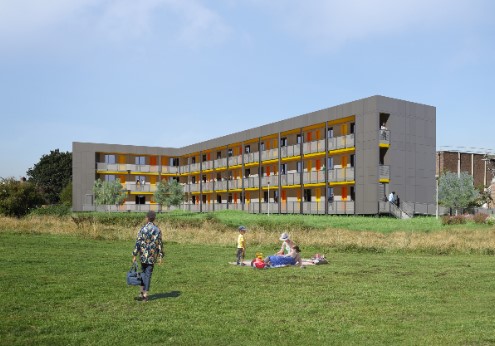
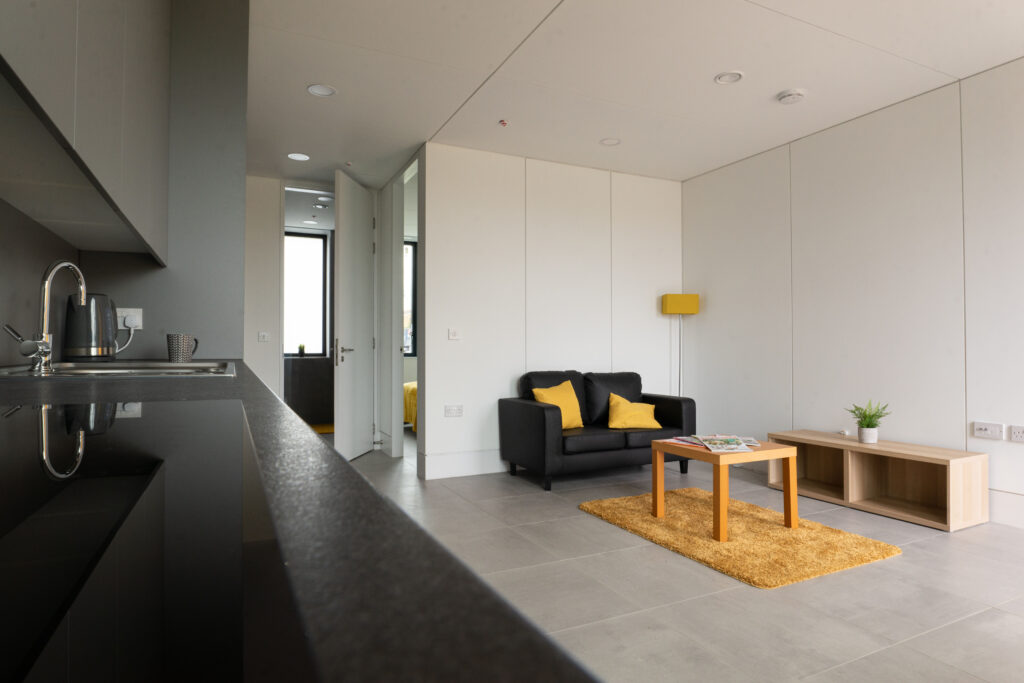
The post What to look for when considering modern methods of construction appeared first on Without Limits.
]]>The post Tackling embodied carbon: how to specify the carbon cost of materials appeared first on Without Limits.
]]>As buildings are currently responsible for 39 per cent of global carbon emissions, the built environment sector has a vital role to play in responding to the climate emergency.
Rahm Emanuel, the former chief of staff to President Barack Obama, is famous for saying: “You never let a serious crisis to go to waste. And what I mean by that is an opportunity to do things that you could not before.” While Emanuel was talking about the 2008 financial collapse, we can apply the same sentiment to the climate emergency and how architects must now focus on reducing embodied carbon when designing new buildings or refurbishing and retrofitting existing ones.
Embodied carbon is defined by the charitable organisation UK Green Building Council (UKGBC) as ‘carbon emissions associated with materials and construction processes throughout the whole lifecycle of a building or infrastructure.’ With many projects now moving into digital common data environments we have access to more data on our buildings than ever before. As we understand more about our buildings, how they operate and the materials from which they are made, specifying the carbon cost of materials is one of the best ways we can lower embodied carbon emissions from the outset.
An increasing number of materials now have Environmental Product Declarations (EPDs) which allow us to review embodied carbon and other environmental impacts. Day-to-day however, we are still learning the best ways to specify carbon cost within the design process. In this article, we discuss the importance of obtaining buy-in from clients at the earliest possible stages, and three key steps for architects and designers to take in collaboration with sustainability and specification consultants.
Making the business case for lowering embodied carbon
Aside from the environmental benefits, lowering embodied carbon makes sound commercial sense. Increasingly, investors are scrutinising clients’ environmental credentials, and many clients have responded by making commitments to achieve net zero carbon emissions well in advance of the UK government’s 2050 target.
A UKGBC report points out investor rating and measurement indices are just starting to include assessments of embodied carbon, namely:
- The Dow Jones Sustainability Index (DJSI) now includes a section about the lifecycle assessment of building materials;
- The FTSE4Good Index asks questions on lifecycle studies and related carbon emissions reductions;
- Not-for-profit charity CDP includes voluntary reporting of Scope 3 emissions (defined as indirect emissions beyond building performance and materials);
- The Global Real Estate Sustainability Benchmark (GRESB) survey has a significant volume of questions on new construction and major renovations.
Three steps to effectively specify material and systems carbon costs
Reducing embodied carbon will accelerate us towards vital overall carbon reduction goals, so how can we do this most effectively? We look at three important steps:
1/Set embodied carbon KPIs
Benchmarking for embodied carbon is still relatively new. The Royal Institute of British Architects (RIBA) set out ‘progressive but achievable targets in its 2030 Climate Challenge document that seek to reduce embodied carbon emissions from the current 2020 benchmark of 600 kg/CO2e/m2 to 450 kg/CO2e/m2 by 2025.
Clients and architects should work alongside their sustainability and specification consultants to set realistic operational and embodied carbon targets at RIBA Stage 1, which can be included in the Project Brief and Outline Specification documentation. Using industry benchmarks such as the one mentioned above is the best way to do this as initial concept designs or feasibility studies aren’t robust enough to model carbon emissions and are liable to change.
Currently one of the biggest challenges is to bring clients on this journey so that they understand and buy into this approach with a clear understanding of the benefits (lower carbon footprint) and implications (design or material changes). Once there is buy-in, then it is vital to ensure that consultant teams have the appropriate scope to undertake the requisite analysis.
2/ Keep an eye on the carbon cost
Having set targets at RIBA Stage 1, it is important to keep an eye on carbon costs and potential material wastage while resolving geometric detailed design, alongside selecting materials in subsequent project stages.
Modelling various design scenarios to assess their carbon cost can be challenging, so involving sustainability consultants early and using carbon calculators is essential to provide feedback to the architects, design team and contractors throughout a project. Clear information, such as adding an adjacent carbon column to cost plans, makes decision making faster and more effective.
Looking to the future we could make the carbon cost even more evident; for example, what if there was a way to see the invisible carbon emissions when visualising projects in virtual reality (VR) environments? With increased adoption of digital tools these ideas may soon become reality.
3/Specify sustainability performance requirements
The new RIBA Plan of Work 2020 Overview tells us “the value brought by the design team delivering Prescriptive Information will vary depending on the building type and the outcomes the client is seeking to achieve.” With this in mind, we advocate the following approach depending on whether items are specified prescriptively or descriptively:
- Prescriptive approach: Where systems and materials are prescribed, i.e. named in the specification, we strongly advise including specific carbon performance details. Making sure that carbon performance details are clearly visible helps ensure that carbon outcomes remain unaffected further down the line. In other words contractors would be able to reference prescribed carbon performance standards when proposing alternative solutions.
- Descriptive approach: Where systems and materials are described, i.e. by reference to performance requirements and design intent information, carbon performance details should be clearly defined. In this instance, the contractor is responsible for completing the detailed design in accordance with the defined performance requirements. Once the detailed design is accepted, the design team is then responsible for making sure the carbon performance requirements are achievable using available systems and materials.
Putting it into practice
Sustainability engineering workshops to action the above steps should be held at the very outset of a project. They are an invaluable part of the process when considering whole life carbon and are highly likely to influence early geometry and massing.
Ascertaining which materials and building methods produce the lowest embodied carbon takes research and investment, and this knowledge needs to be amassed and used from project to project. Feilden Clegg Bradley Studios has developed its own carbon calculation tool to advise their design teams and also has a full-time researcher to advise on the best materials to use to lower embodied carbon. Heatherwick Studio is working with AECOM’s Specification Consulting team to build a library of materials and their sustainability data to inform future designs and lower their embodied carbon.
In the near future, it is possible that British Standards will be created to set an important benchmark for our industry to measure embodied carbon in a unified way. Until then it is vital that designers, engineers and consultants work together to share data so we can specify a better built environment for generations to come.
The post Tackling embodied carbon: how to specify the carbon cost of materials appeared first on Without Limits.
]]>The post Rethinking planning: 10 big changes the forthcoming English reforms should address appeared first on Without Limits.
]]>AECOM’s planners agree that the creaking planning system, weakened and complicated by repeated tweaks, does need a reboot. But we argue that the English system needs to be joined-up and visionary rather than continuing to rely on a piecemeal approach.
Much of the media commentary has been about changes to development management to underpin recovery and as stimulus to the development industry. The main thrust of which is to make it easier – or no longer necessary – to secure planning permission. On its own, such deregulation will not create the future places and communities we need, nor will it enable well-rounded decisions to be made on where to build, regenerate or protect.
As a starter for 10, here are some of the changes we believe should be included in the forthcoming reforms:
1.Effective strategic regional plans
Unlike the devolved nations of the UK, England (with the exception of London) does not have full statutory planning above the local level. Indeed, England is the only country in Europe lacking a regional or national vision. This means big decisions on growth must be made at the sub-regional scale – a big ask for local authorities with different ways of doing things, limited capacity and competing priorities.
Development corridors such as the Oxford-Milton Keynes-Cambridge arc, focussed around common economic, infrastructure or community priorities are already going some way to address this gap by bringing together stakeholders to achieve shared outcomes. Similar approaches are needed across areas where transformative infrastructure is to be targeted – the Northern Powerhouse Rail/Trans-Pennine corridor, perhaps?
If government is serious about place-based solutions to balance development pressures in over-heated areas and levelling-up the under-performing parts of the country, it must ensure that regional or corridor spatial and economic plans are considered at the national level. A new devolution white paper is promised for the autumn and regional planning must form part of the toolkit.
Under the current system, there are significant barriers to sub-regional and corridor-scale growth. If this can’t be done at an England-wide level, we recommend replacing the shambolic Duty to Cooperate – introduced in 2011 to require local authorities to work together on strategic planning issues – with a more effective strategic planning mechanism. A requirement to produce joint plans is needed, underpinned by a “Duty to Agree”. A developed regional spatial planning structure will provide the context for this shift of emphasis.
2. A new role for Local Plans: Support for building new homes in the right places
With regional spatial plans in place, Local Plans will be able to focus better on local issues. The new regime needs to give local authorities more teeth to ensure that plans for new homes are built in the right places – i.e. where the infrastructure is or can be provided and at a scale that means local facilities and services are viable and accessible to all. This could mean that housing demand is met by development in adjacent authority areas if this is the more sustainable location, aligning to transport infrastructure and avoiding environmental or flood risk areas.
This approach would support genuinely sustainable development rather than the current developer-led process which can result in piecemeal growth in areas which aren’t necessarily well served by public transport. In such areas, developers or government investment should provide the infrastructure upfront – which includes education, medical and social provision to build cohesive communities.
To meet the government’s target of building 300,000 new homes a year and to deliver on the levelling up agenda, a national system is required to ensure development happens around the country in places which make sense. Decisions should be based on sound economic, demographic and environmental data – a departure from planning based on market signals, which has focussed development in the places where land values are highest rather than lower demand places where investment is needed. This will need to be underpinned by public sector infrastructure investment and direct delivery to de-risk and incentivise the market.
3. Make garden communities a reality
Garden communities are large-scale strategic new developments of at least 1,500 dwellings – usually urban extensions or stand-alone new communities. These new community developments need bespoke planning approaches which can accelerate growth but maintain quality and flexibility over 10-20 years of delivery. The current system fails local authorities who think big on strategic growth, so alternative approaches are needed. Local Development Orders, already on the statute books, which provide permitted development rights for specific types of development in defined locations, should be used to promote and consent Garden Communities rather than Development Consent Orders, which are required for large developments deemed nationally significant infrastructure projects but are not flexible to the changing needs of a community development as it grows and matures.
Using LDOs means garden communities can be promoted along with the Local Plans, resulting in a more evidence-based examination. If granted alongside the Local Plan, there will be no need for a subsequent outline planning application, saving time and money.
4. Enhanced use of Development Corporations
Promoting the larger Garden Community programmes (potentially for 20,000 or more homes) is beyond the capacity of many local authority planning departments and, indeed, the planning system itself. Similarly, major regeneration projects which bring urban land back to economic or environmental purpose require the mediation of so many stakeholders that their development is often fraught with delay. In addition, if local authorities are resource constrained then there are only a handful of master developers and developer/investors able to work at the scale of the complex and transformative brownfield and greenfield projects we expect in the coming years.
The appropriate resources, including top-level political support and certainty of funding for infrastructure, should be provided to the promoters of new community and complex regeneration projects. Such resources may include enhanced roles and powers for Development Corporations, dedicated bodies set up to deliver large-scale and complex development, blending local leadership and the heft of government. Such delivery bodies have an excellent track record in delivering sustainable growth at this scale – particularly from the 20th century new town programme. Government is considering1 a potential wider role for them to facilitate growth. The corporation model may also create the context and certainty of commitment that developers and investors need to engage in some of the most complex urban projects. Accelerating the use and powers of development corporations should form part of the planning system review.
5. A focus on the future of town centres
Much of the drive from government for planning reform has centred on the need to accelerate housing delivery. Recently, the decline of retail has pushed the challenge of supporting struggling town centres to the fore and significant resources are now being channelled into the Towns Fund schemes. However, the economic impacts of coronavirus have highlighted the structural fragility of town centres. At the same time, new value has been placed on local services and retailers who’ve been serving local communities during lockdown.
To flourish, town centres need to be at the heart of places of all scales, and a focus for a levelling-up and wellbeing agenda. This will not be achieved by flexible permitted development or changing the Use Classes Order to make it easier to change the function of a building or land. Town centres need special attention in the planning reform package requiring the thought through downsizing of protected retail-only frontage, promotion of new forms of local co-working space, encouragement of high-quality, mixed town centre living, and encouraging the move of public social infrastructure back into central areas.
6. Reform Strategic Environmental Assessment practice
Planning reform needs to add a new land use dimension – the enhancement of environmental and wildlife assets. The new Environment Act2 formalises the concepts of Environmental and Biodiversity Net Gain from building and infrastructure developments. Consequently, it is essential that this requirement is reflected in new planning legislation.
The Strategic Environmental Assessment Regulations3 already require the potential environmental effects of development to be considered alongside social and economic issues4, embedding environmental assets in land use plans. However, to value environmental capital equally alongside economic and housing priorities, the SEA needs to be at the heart of policy creation. In particular, it should inform how the unbuilt environment can make a positive contribution to growth opportunities and to tackle climate change impacts. This work should include the comprehensive review of Green Belts so that they are no longer a passive constraint, but can contribute fully to housing needs, where appropriate, and to environmental and biodiversity capacity close to our metropolitan areas.
The SEA legislation aims are admirable and ensuring a systematic consideration of alternatives remains crucial. However, in reality such assessments have often been done badly and are sometimes undertaken to justify the strategic development decisions already made rather than to inform options and policy development. The legislation does not need reform. It needs boosting in importance as a tool to inform and justify, not just post-rationalise, land use planning decisions.
7. Ensure sites allocated for green infrastructure in Local Plans
Reserving space for natural or semi-natural features will ensure environment considerations are treated on a level playing field with housing and employment concerns. For many developments, this will involve a requirement for on-site provision. When large-scale developments or high-density urban schemes cannot provide suitable provision locally, they will also need to identify strategic off-site land resources. Funds from developers should be channelled into the restoration and long-term protection and management of these natural sites.
To realise the greatest benefits of the pooling land and financial resources, landowners and local authorities need to work together to identify and protect the identified areas. If environmental net gain is to be an enabler of growth and not a constraint, this is another area where local authorities may need to effectively co-operate with others in their city region. Planning reform should look to embed the identification of net gain locations, informed by the SEA process, in strategic and local plans.
8. Make the Manual for Streets mandatory
The anticipated planning reform legislation will focus on planning delivery in England, but the primary legislation should not overlook issues of quality. To bring to life the government’s ‘Building Better, Building Beautiful’5 agenda and to improve the attractiveness of active travel (walking and cycling), the reform package should address the long overdue need to improve the quality of streets and urban realm. The recent National Housing Design Audit came to the same conclusion as those of a decade ago: highway design is dragging quality down to unacceptable levels, designing in private car dependency.
Originally published in 2007, the Manual for Streets provides guidance for practitioners in England and Wales involved in the design and planning of new streets. The laudable aim of this national guidance is to make development more people-oriented and reduce dependence on private motor vehicles. An updated Manual for Streets is being prepared: it should be made mandatory as part of the wider reform package.
9. Establish a Design Quality Unit
We welcome the government’s increasing commitment to the importance of good design6 but this runs the risk of getting lost in the planning reform proposals. If the planning system is to be freed-up and sped-up there should at the same time be an emphasis on the quality of buildings and places. Indeed, quality should have a heightened role in informing design-making. To be effective, such ambitions need to be supercharged by a dedicated agency to support developers and local authorities in promoting good design practice.
10. Properly resource local planning authorities
Our final point concerns local authorities’ ability to respond. Whatever form planning reform legislation takes there will need to be well-resourced and skilled planning teams in local authorities and devolved bodies to enable effective implementation.
Cuts to local authority budgets over the past decade7 have resulted in very limited capacity to develop and implement policies and projects needed to advance levelling up. Developers have long called for the proper resourcing of planning authorities to enable efficient and high-quality processing of proposals. Even before the full impact of the coronavirus pandemic was felt, some were saying that it was “ambitious”8 for local authorities to meet the 2023 target for getting a Local Plan adopted, with two-thirds of councils lacking an up-to-date plan9.
Today, lost income related to the coronavirus lockdown has hurt the finances of many local authorities10, with planning departments particularly affected. Implementing and delivering a new planning system requires adequate resourcing, which should be part of the reform package.
Ready to respond
Planners have a significant role in helping to address the economic, societal and environment challenges post-coronavirus and deliver on the government’s levelling up agenda. When the government publishes its policy paper, AECOM’s planning teams are poised to respond, arguing for the most effective framework for planners and the development industry to deliver.
[3] Environmental Assessment of Plans and Programmes Regulations 2004
[4] https://www.gov.uk/guidance/strategic-environmental-assessment-and-sustainability-appraisal
[6] https://www.gov.uk/government/groups/building-better-building-beautiful-commission#reports
[7] https://www.centreforcities.org/reader/cities-outlook-2019/a-decade-of-austerity/
[8] https://www.planningresource.co.uk/article/1678416/why-councils-may-struggle-meet-governments-new-local-plan-deadline
[9] https://www.theplanner.co.uk/news/two-thirds-of-councils-have-no-up-to-date-plan-suggests-research
[10] https://www.theguardian.com/society/2020/jul/13/english-councils-poised-cuts-services-job-losses-loss-commercial-income
The post Rethinking planning: 10 big changes the forthcoming English reforms should address appeared first on Without Limits.
]]>The post Data centre delivery: faster, smarter, better appeared first on Without Limits.
]]>Global demand for data is increasing. In order to meet that demand, data centres operators are required to deliver at increasing pace, with speed-to-market and cost-effectiveness top priorities. At the same time, with net zero emissions targets high on the agenda, data centre owners are under pressure to build more efficiently and to deliver and operate greener buildings and infrastructure. The good news is that the use of digital solutions can help manage these conflicting demands.
Both the design and construction industries are moving towards leaner and greener methods to meet carbon emission reduction goals. Technological advancements are bringing about new ways to optimise project delivery, increase productivity and create efficiencies throughout the design and construction process – all key principles for the data centre sector. Efficient design tools, the use of artificial intelligence and machine learning automate repetitive manual tasks, enabling greater creativity whilst providing more reliable design and construction outcomes.
The wider benefits of a digital approach
Many projects still follow the generations-old linear process of briefing, design, construction and finally, occupation — with maintenance and facilities management considerations frequently an afterthought.
Digital innovation affords teams the opportunity to access and benefit from the latest innovations in advanced manufacturing, design and construction, while facilitating the shift to a more circular lifecycle approach. Digitally integrated platforms help multidisciplinary teams and supply chain collaborate more resourcefully, making complex, often global, programmes simpler to manage while reducing downstream costs.
Informed by our digital expertise and global experience, AECOM has developed a platform which brings together the latest digital tools. The platform is built around a central digital library that enables knowledge capture, supports interdisciplinary workflows and applies lessons learnt to deliver smarter, faster and better.
Digital solutions facilitate informed decision-making from project inception through to operation, all of which help to:
- understand design implications and manage change control;
- maximise specification selection and management of materials or equipment;
- increase collaboration across geographies to streamline communication and intensify innovation.
Benefits specific to data centre delivery
An integrated digital delivery approach can transform processes and improve outcomes across the data centre lifecycle. Here are five specific benefits:
1/Design
Digital methodologies optimise processes, add value and encourage innovation. Showing designs in a virtual way reduces the need for two-dimensional (2D) drawings and increases design efficiency, specifications, costings and programming as a result. Next-generation Building Information Modeling (BIM) authoring tools and Technical Quality Review procedures (an internal quality control procedure developed by AECOM) allow stakeholders such as design partners to review digitally, leading to better design decisions. As an example, a cross-section through a typical hot and cold aisle can be conveyed in a much more tangible manner using digital tools than via traditional 2D output.
2/Phased deployment
Data centre facilities are deployed in phases to maximise operational capacity. These general arrangement plans are usually demonstrated through traditional 2D output. However, implementing 4D BIM for construction sequencing allows the process to be animated, potentially drawing upon machine learning capabilities to better evaluate and establish the most efficient way forward. This process was especially useful for one of our hyperscale clients in seeing the entire lifecycle of their development and facilitated much better stakeholder engagement with design teams, contractors and local communities.
3/Optimal orientation
Used at the masterplan stage, digital tools can establish optimal building orientations offering up operational efficiencies that can help reduce future energy demands. For example, these tools can analyse the best wind directions to help control building temperatures or model for hot spot areas that will require greater cooling.
Furthermore, computational fluid dynamics (CFD) analysis allows us to see how liquids and gases flow around the data centre, vital to fully assess heating /cooling and ventilation strategies. We were able to use CFD modelling on a hyperscale project to ensure the best design was met, which ultimately saved time and costs.
4/Mitigating risk
Leveraging BIM with pedestrian traffic simulation software allows the analysis of pedestrian flow within a building or given scenario. Given the amount of electrical equipment housed within data centres, planning for fire safety should be a key focus, so being able to simulate and evaluate escape distances and egress points within a given footprint can be valuable when mitigating safety risk.
5/Plant replacement strategy
Data centres are densely populated with maintainable assets that may need to be replaced periodically. Commissioning and facilities management processes can benefit from machine analysis of the most efficient routes for plant replacement based on worst case scenario equipment dimensions. For operators with a large portfolio of data centres, this form of digital asset management can offer economies of scale and greater efficiency in getting a better understanding of the commissioning process and an overarching view of global asset management.
Truly transformative
Harnessing the power of digital transformation, connecting data and collaborating with key partners will help solve the complex challenges faced by the industry both now and in the future. There is no doubt that embracing digital delivery solutions early has a truly transformative impact in helping design and deliver new data centres faster, smarter and better.
The post Data centre delivery: faster, smarter, better appeared first on Without Limits.
]]>The post The carbon and business case for choosing refurbishment over new build appeared first on Without Limits.
]]>The built environment demands around 40 per cent of the world’s extracted materials while waste from demolition and construction represents the largest single waste stream in many countries.
Together, building and construction are responsible for 39 per cent of all carbon emissions in the world, with operational emissions (from energy used to heat, cool and light buildings) accounting for 28 per cent. The remaining 11 per cent comes from embodied carbon emissions, or upfront carbon that is associated with materials and construction processes throughout the whole building lifecycle.
To meet the UK government’s commitment to reduce net carbon emissions to zero by 2050, the building industry has a big role to play, requiring radical cuts in emissions from construction and operation.
In this article we examine the environmental case for refurbishment, and how that is guiding policy change. Historically, there have been powerful incentives – cultural and financial – favouring new build, but this is changing – and the business case for refurb and rebuild is growing.
Embodied versus operational
The perception is that building new will radically reduce carbon emissions in operation compared to an existing building. However, those savings will only be achieved in the future and even when operational emissions are reduced, constructing a new building means paying a heavy upfront toll in terms of carbon emissions from the extraction of raw materials, transport and construction.
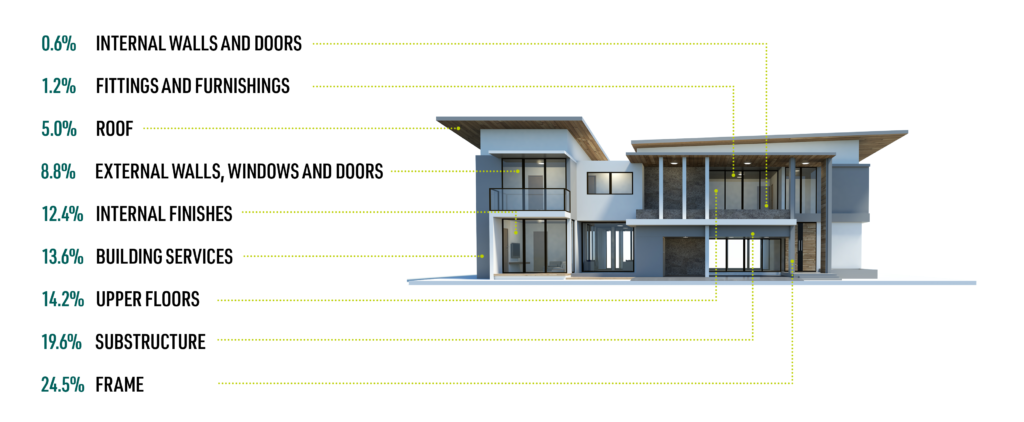
In contrast, a deep refurbishment of an existing building can also cut operational carbon emissions — without the emissions associated with building new. Embodied carbon covers the total emissions arising from constructing a new building and its end of life. Figure 1 shows that over 60 per cent of embodied carbon emissions are associated with the sub structure, frame, upper floors and roof of a building. A deep refurbishment should retain these elements, meaning on average, the carbon footprint of a refurbished building is half that of the newly-built replacement.
The environmental case for refurbishment
Research by the London Energy Transformation Initiative (LETI), a network of over 200 built environment professionals, shows that buildings must reduce their carbon footprint or embodied carbon emissions in the future if we are to achieve net zero. LETI has proposed an embodied carbon budget of 600 kgCO2e/m2, which is a tough call given that a typical commercial building would have 1,000 to 1,500 kgCO2e/m2. With a new building, basements and structural frames require tonnes of concrete, steel and aluminium which account for about a third of the embodied carbon as shown in Figure 2.
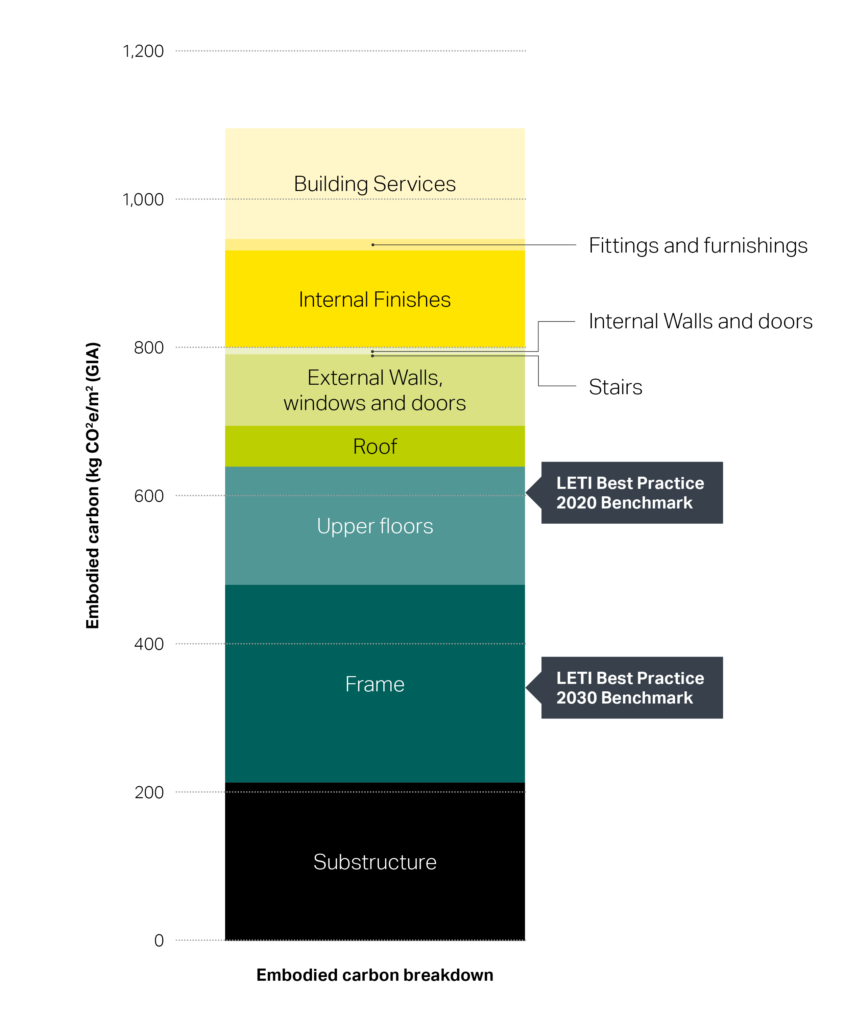
A deep refurbishment can retain the sub-structure and structure and still provide excellent fabric performance – as judged by retrofit-specific standards such as Enerphit. By choosing the right fabric, some buildings can reduce heat demand and provide equivalent or better lighting and ventilation standards as a new building. Of course, not all buildings will be suitable for net zero carbon retrofit, but with ingenuity a lot more can be done than you might think. Key considerations will include massing (how the building looks in terms of shape or mass), floor-to-ceiling heights, depth of floor plate, and the positioning and size of cores. Replacing the building fabric and the building services can make a huge difference.
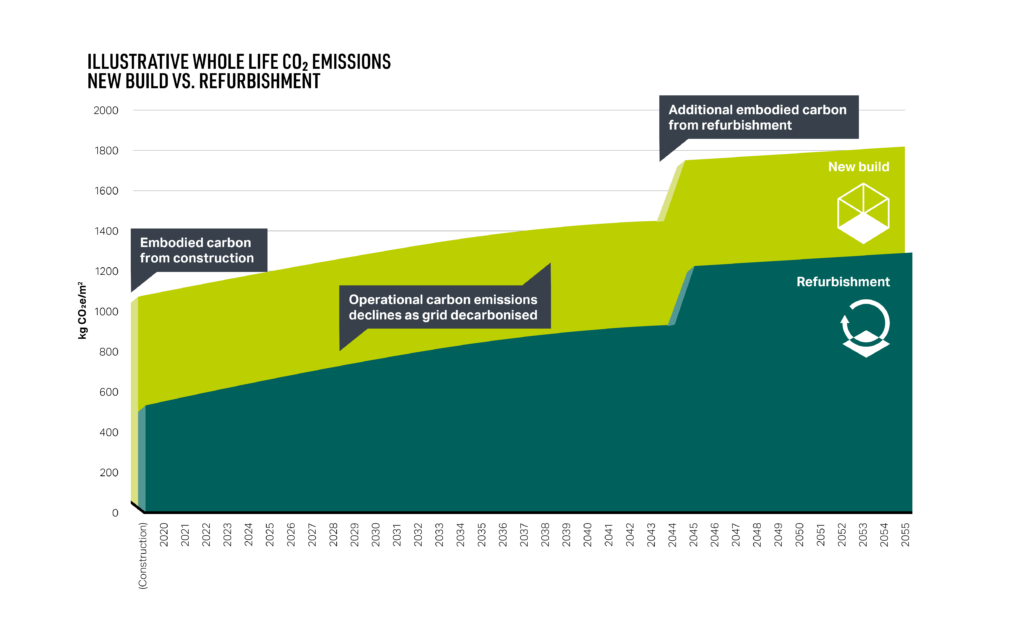
Because of the significant embodied carbon impacts of new buildings, any savings from operational energy use would not compensate for the initial emissions, as illustrated in Figure 3.
Figure 3 assumes an initial embodied carbon for new build based on AECOM research alongside a refurbishment scenario that retains the sub-structure and structure of an existing building. There is a further refurbishment after 25 years that covers the building services and interior fit-out. The operational carbon emissions are adjusted using the projected carbon emission factors for electricity which can be seen by the gradual decline in the operational emissions over time.
The graph shows clearly how many emissions are front-loaded with new buildings, whose environmental credentials are based on promises of lower emissions in the future. To reduce the risks associated with climate change, emissions need to be cut now.
Staying ahead of policy change
If the best way to achieve the net zero carbon targets is to refurbish whenever possible, why is this not in legislation and planning policy? Things seem to be edging in that direction, but there are some major impediments.
In its draft London Plan, the Greater London Authority has set out design principles for projects that prioritise retention and refurbishment (see Figure 4). When adopted, the city region’s statutory spatial development strategy will require a Circular Economy Statement demonstrating how products and materials will be recovered and re-used for all referable projects, as well as a Whole Life Carbon assessment, covering embodied and operational emissions. This is reinforced by the Circular Economy Statement guidance that questions whether there is an existing building on site and whether that building can be retained.
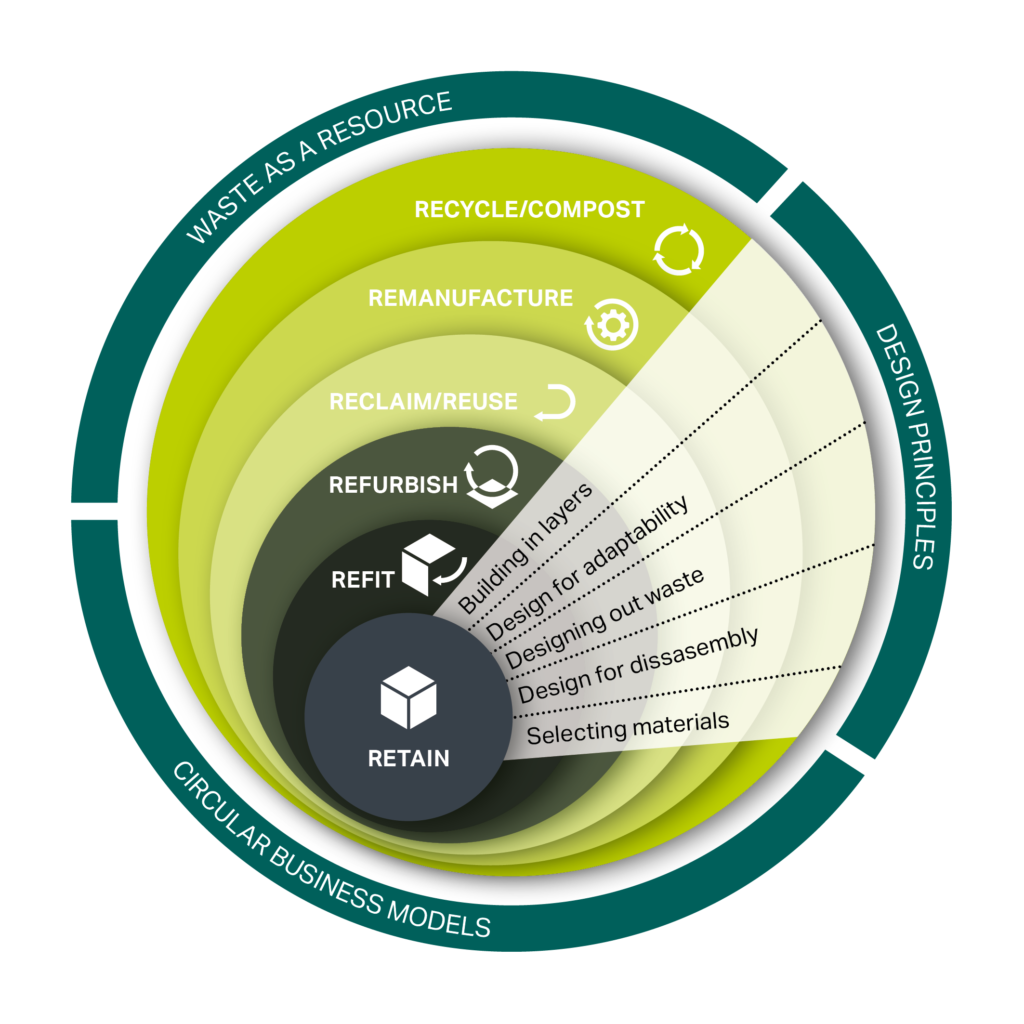
The London Plan requirement for Whole Life Carbon assessment is now included in the Energy Strategy Guidance to encourage applicants to consider the embodied carbon impacts as well as the operational energy performance of proposed new developments.
The Royal Institute of British Architects (RIBA) also recently launched a Retrofit First campaign, championing the reuse of buildings. This has highlighted the long-running problem of a 20 per cent VAT levy on refurbishments as opposed to 0-5 per cent on new build. This creates an incentive to build new instead of refurbishing. RIBA is campaigning to cut the tax to 5 per cent for refurbishments to help to level the playing field.
These are steps in the right direction, but when sites are being procured and when an organisation is looking for more space the incentives to favour new build are still manifold. This will change if policy pushes it in the other direction.
The business case
As well as the carbon incentives, there are other powerful arguments for retaining buildings in our towns and cities. Early option appraisal and planning, together with data analysis can help guide decisions, often before a site is acquired.
With an existing building, there is a lower level of risk involved and the refurbishment programme can be much shorter. New build can take five years from inception to hitting the market, by which time workplace practices and technology expectations will have changed. It is becoming increasingly important to get buildings to market quicker. For example, the Crown Estate’s BREEAM Outstanding refurbishment project on 7 Air Street took only one and a half years from inception to completion but would have taken over three years to build new.
Tenants and occupiers are also becoming more discerning about the buildings they occupy and procure. Awareness of the climate crisis is forcing many to assess their choices and may well drive demand for buildings with lower embodied carbon as well as operational energy. Organisations that own property portfolios are certainly under pressure from the policy agenda and from public perception to show radical reductions in emissions and constructing a new building will reverse their downward trajectory towards net zero and incur additional costs to pay into offset funds.
Refurbishments can look as modern as the freshest of new builds. Organisations such as Derwent London have built their reputation on high quality refurbishments including The Tea Building in East London and the Johnson Building in Central London and have been instrumental in driving awareness of the benefits of cherishing and pumping new life into existing buildings and streetscapes.
We know that new buildings can inspire, but so can refurbished ones. In the future, we are likely to see developers actively looking for buildings that are ripe for refurbishment rather than development. If we’re to achieve our net zero ambitions, it is the only way.
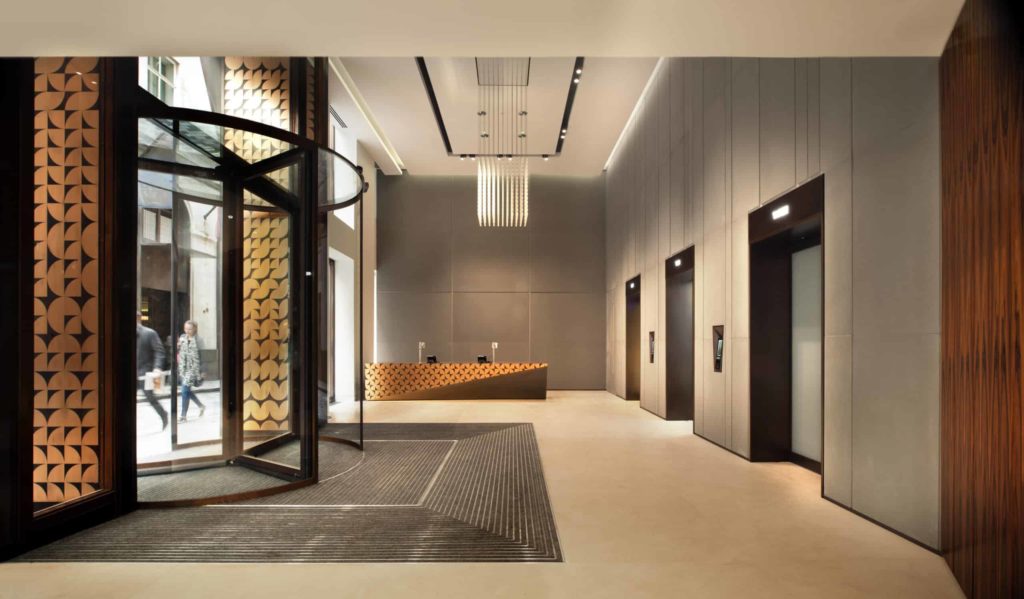
View and download the full article here
The post The carbon and business case for choosing refurbishment over new build appeared first on Without Limits.
]]>The post Why build to rent is flourishing in Birmingham appeared first on Without Limits.
]]>Build to rent (BTR) may be booming across the UK, but Birmingham has taken a while to get the message. Now at last that is changing.
Projects such as Nikal’s major city centre development Exchange Square 2 and Blackswan’s Gilder’s Yard are part of an expected pipeline of around 5,000 units around the city. They join existing landmarks such as Exchange Square 1, the Lansdowne in Edgbaston and the Forum in the Chinese Quarter in bringing critical mass to Birmingham’s BTR sector.
Shifts in the Birmingham’s economics and demographics are combining to provide fertile ground for BTR to take root. There’s been significant inward investment over the last decade and organisations such as HSBC and HMRC have brought jobs. Transport infrastructure has been renewed and new cultural landmarks built.
Birmingham’s population growth has been steady, prompted by new jobs and the city’s five universities, which produce 67,000 graduates a year, 50 per cent of whom stay on after graduation. Add to this the West Midlands Combined Authority’s target to build 215,000 new homes over the next two decades, and the result is a big opportunity for BTR funders and developers.
Indeed, in this market, the city’s relatively late entry may work in its favour, with developers able to capitalise on lessons learned from other, earlier projects across the country. We outline some of those key considerations below:
1/Taking a long-term view
Institutionally-backed BTR projects are all about the long haul, so developers entering this market need to build their knowledge and understand the running costs. Balancing capital expenditure and operational costs will enable them to get an accurate picture of a scheme’s returns.
This is the difference between BTR and open-market schemes — even those destined for the private rental sector. With BTR, the organisations and institutions that forward-fund its construction will usually be around for the next 30 years of operation. And while returns on a BTR project are generally lower than for those in the open market, the long-term gains can be substantial.
2/Understanding the end users
A clear understanding of a BTR building’s end-users will also be essential to funders and developers who require a successful return on investment. 75 per cent of Birmingham’s city-centre inhabitants are under 35 years old, so the standard profile of a BTR tenant as a young, single occupier still rings true.
That said, the tenant landscape is diversifying. Surveys show families, older working renters and retired baby boomers moving into BTR properties. These tenants will have different criteria when searching for a rental property so developers and designers must decide how best to accommodate them.
However, common to all will be a need for appropriate amenities, decent transport as well as a good level of maintenance and management support.
3/Specifying for success
The standard one-bedroom configuration may not be the best fit for the diverse BTR demographic. Offering homes with more bedrooms and a variety of building typologies may be a better fit for local housing needs. Nevertheless, the overriding ambition must be to deliver an efficient building with acceptable whole-life maintenance overheads.
Showy, expensive buildings – such as tall towers – may build brand identity in an emerging market, but they may take longer to recoup their build cost. Developers should challenge design teams to make ease of maintenance and management a critical path from concept design onwards.
4/Sustainability and standardisation
Sustainability must be an integral part of the design and construction phase. Green technology and renewable energy should complement efficient thermal performance, backed up by responsible sourcing during procurement and construction.
Furthermore, standardisation of products and components will help bring down the overall cost of a scheme, especially if a developer is looking to build out several schemes in the city. Approaches such as modular and offsite construction can bring factory‑style safety, efficiency and quality to a project.
Cost breakdown
Our cost model represents a medium-quality BTR scheme in central Birmingham that comprises a 20-storey residential tower, providing circa 200 units with an average apartment size of 63 square metre (sq. m). The scheme includes ground-floor amenity space with a concierge facility, gym and cafe/lounge area.
View and download the cost model here.
An edited version of this article first appeared in Building magazine in January 2020
The post Why build to rent is flourishing in Birmingham appeared first on Without Limits.
]]>The post Garden communities: delivering the dream appeared first on Without Limits.
]]>Garden communities are an important part of the government’s ambitious plans to increase housebuilding to an average of 300,000 net new homes a year by the mid-2020s. Recent research by planning consultancy Lichfields estimates that the 49 potential garden communities could provide 403,000 homes, up to 180 primary schools, 56 secondary schools and 600 hectares of employment land.
In order to do this, we estimate that £70 billion would need to be spent. Correctly applied, this spend means that garden communities could have a crucial role to play in the UK’s economic recovery post coronavirus.
However, current delivery is not keeping up. Lichfields’ report also found that of the 49 projects identified since 2014, only 3 per cent have been completed. Of the remaining 97 per cent, we estimate that 60 per cent still need to go through the first step of obtaining local plan allocation (never mind outline planning consent and moving forward to build out). Speed through these stages is required if targets are to be met.
Yet experience sounds a warning bell. The 2020 housing audit carried out by University College London for countryside charity CPRE and the Place Alliance found that 75 per cent of 140 audited housing developments were mediocre at best. Clearly, delivery at pace is not everything: quality must remain firmly in the frame. To that end, the independent Building Better, Building Beautiful Commission has recently set out over 100 policy recommendations for government and planning bodies.
An integrated, evidence-led approach to masterplanning
AECOM has developed the ‘Masterplanning ie.’ methodology to help project promoters overcome typical challenges and resolve associated risks so they can deliver high-quality garden towns and villages faster.
With so many recommendations to be conscious of in order to demonstrate a “commitment to quality” and possibly open a “fast track for beauty” as outlined in the commission’s report, taking the following steps will help local authorities and their development partners deliver the dream of high-quality sustainable garden communities.
- STEP ONE: bring in technical expertise at the outset. Undertaking a comprehensive initial briefing and evidence-gathering process at the start is hugely beneficial. At the outset, we bring together around 20 different professional skill sets that are typically required to develop a new community masterplan to collectively address the environmental, economic, social and physical aspects of sustainable large-scale development. This allows us to de-risk projects and create robust masterplans that bring more certainty into the planning and delivery phases. This integrated, evidence-led approach also leads to smoother and faster masterplan completion compared to conventional methods.
- STEP TWO: appoint a PMO or lead consultant. Once the masterplan is completed and outline planning consent has been achieved, the focus will shift to the complex delivery phase. This includes the procurement of development partners and contractors to deliver infrastructure, community facilities, open spaces and build the new homes. The early appointment of a PMO or lead consultant is highly advisable to prevent this process getting too ragged and ensure best value is delivered by the supply chain. The PMO or lead consultant should also bring all the technical expertise garnered at the masterplan phase to bear on the delivery, making sure this work is not lost and fully informs the next phase.
- STEP THREE: embrace connected data environments. The best way to harness the large amount of information gathered is to embrace a connected data environment, such as Autodesk BIM360 or Bentley ProjectWise. Both are widely used by AECOM across complex projects to provide accessible and secure information management as well as cost and progress transparency to clients and stakeholders. In addition, the PMO or lead consultant should use an integrated programme management tool such as the Digital PMO, which will bring together the multiple management systems to allow visibility, control and assurance of all aspects of the projects within the programme.
- STEP FOUR: think programmes not projects. Thinking about a large and complex scheme as a series of projects increases complexity, reduces opportunities for innovation and risks information being lost between parties. It’s much better to plan a holistic programme of work. As well as improving coordination and transparency for the client, this approach makes sure you identify the desired outcomes, define the strategy, then structure and drive the delivery of the programme to secure the benefits. It can also enable the introduction of more digital-led design such as digital libraries, which AECOM is using on programmes of work across the UK to reduce waste in the supply chain, improve sustainability and control cost.
A decade of delivery
Looking further ahead, the next decade promises significant change in terms of the way we live as well as the way we build. As the steps above show, delivering new communities to relieve the acute housing pressure in our increasingly dense cities can be done well and at pace.
The build out spend will provide much needed stimulus to the UK economy providing homes and jobs. However, it is vital that garden communities are built beautifully and sustainably so that they provide strong foundations for future communities to thrive.
CASE STUDY: Northern Arc at Burgess Hill, Sussex, UK
Homes England has been bold in using land acquisition, funds, power and influence to increase the pace, scale and quality of delivery. AECOM is the lead consultant for its Northern Arc project at Burgess Hill, a major development that will deliver up to 3,500 new homes in mid-Sussex.
Using our Masterplanning IE approach, we achieved Local Authority approval for the site wide masterplan and Infrastructure Delivery Plan in under four months and Outline Planning Permission with a signed S106 Agreement in 16 months.
This accelerated programme was made possible by highly effective working across the entire client, consultant and Local Authority teams and was underpinned by an initial Masterplanning IE process that effectively engaged all the stakeholders to create a masterplan that was supported by all the necessary technical evidence.
For example, flood risk and drainage technical expertise was deployed at the outset. This allowed strategic-level Sustainable Drainage Systems (SuDS) to be integrated into the masterplan, and the impact of climate change on fluvial flooding to be mitigated. Drainage schemes were considered in conjunction with other design disciplines for a range of development layouts and residential densities. This resulted in highly beneficial design synergies – SuDS now contribute towards the biodiversity scheme and complement the landscape design. In this way, flood risk and drainage are managed sustainably and with confidence, whilst improving outcomes and achieving the client’s objectives.
As lead consultant, AECOM is now taking the programme forward, providing multidisciplinary services to support the accelerated delivery of infrastructure and new housing at the 176-hectare site.
Ken Glendinning, head of strategic land at Homes England, said: “Burgess Hill is a great example of how we’re unlocking complex stalled sites to build more homes more quickly where they are most needed. Appointing AECOM as lead consultant means we are working with the team to quickly progress the site and ensure the delivery of quality new homes, community facilities and infrastructure that the local community needs.”
A priority project for Homes England, this development will be a blueprint for delivering high-quality new homes and infrastructure at pace. Supporting Homes England’s vision, our work will set high standards of design quality and enhance biodiversity and green infrastructure to help create a great place to live, work and visit for existing and future communities in Burgess Hill.
The post Garden communities: delivering the dream appeared first on Without Limits.
]]>